Author's posts
Aug 24
Demo Alert: Big Bend and Clayton
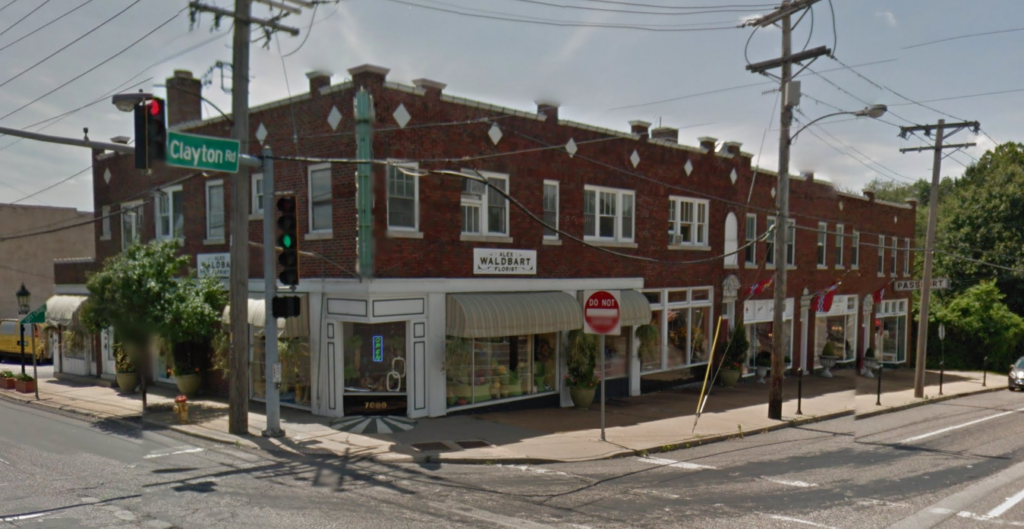 40 South News reports that Richmond Heights is considering a plan to replace the building at Big Bend and Clayton with an urgent care facility.
40 South News reports that Richmond Heights is considering a plan to replace the building at Big Bend and Clayton with an urgent care facility.
The owner of one of the operating businesses in the occupied building is none to happy about it:
Jon Paul had several comments. He said he heard about the plan on Thursday last week.
“They’re taking away the nostalgic look of the town with all this building **** that they’re doing that looks like crap,” he said. “It’s a historical building and it could have been redone to where it would look phenomenal. The people who are doing it want to buy the building and tear it down and Richmond Heights is letting them do it. There’s nothing we can do.”
I couldn’t find any renderings or site plans on the Richmond Heights website. One has to go in person to Richmond Heights City Hall 8:30-5:00 M-F to see related documentation. Pretty pathetic transparency. I suppose such a small city just doesn’t have the capacity to inform citizens by putting such things online. Here is the meeting agenda for the Plan and Zoning Commission which will meet August 24th at 7 pm.
PUBLIC HEARING: PETITION 2017- 10: TAUC Properties LLC, Mark Harriman, Joe Godfrey, Dr. Matt Bruckel seeking Site Plan Review to permit the construction of an urgent care medical facility at 1005 S. Big Bend Blvd.
About Richard Bose
Aug 23
Rents Rose Fastest in Skinker DeBaliviere
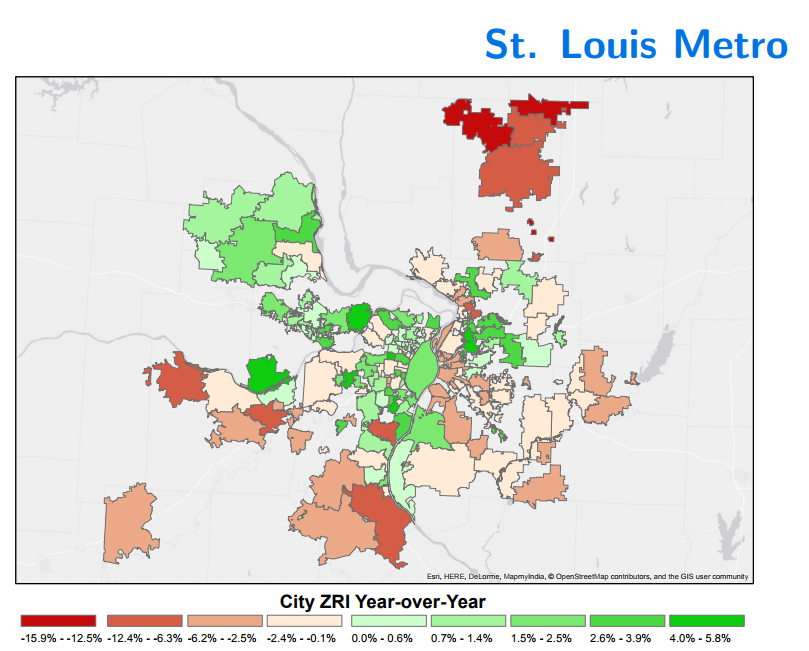 {Zillow}
{Zillow}
Great news? According to Zillow’s May 2017 Rental Market Overview, Skinker DeBaliviere has shown the largest increase of any St. Louis neighborhood in annual rents, a 12.9 percent gain. The only other neighborhoods where rents grew by more than 10 percent in the last year were Vandeventer (11.2 percent), and Tiffany (10.3). Notably, the increase in rents in our neighborhood was also higher than any town in the St. Louis Metro area, including towns in St. Charles County and Metro East in Illinois. People clearly want to live here, and we are on a roll. If you own rental properties in the neighborhood, this news might make you feel like breaking out the champagne. It also might give you some second thoughts about selling when you get those unsolicited letters from real estate operators asking to buy your home, as so many of us on my block seem to. If you own property in the neighborhood, then what’s not to like?
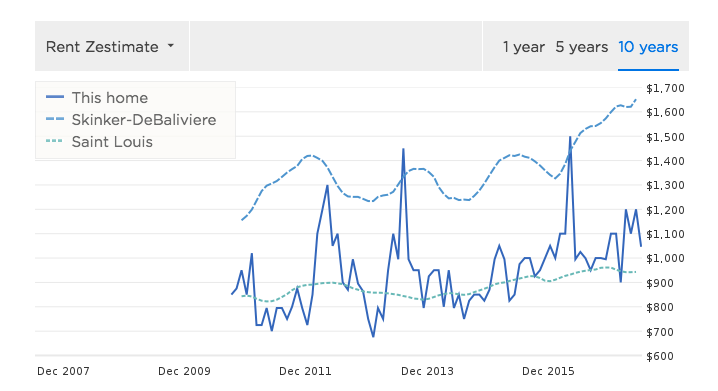 {Zillow}
{Zillow}
Well, even if you like and will benefit from higher rents, don’t count your chickens. At the current rate of increase, if sustained, rents in our neighborhood would double in only six years, a highly unlikely course of events. All the areas seeing the highest growth in rents right now are also parts of town with significant ongoing rehab projects and/or new construction. But be advised that other parts of town with building/rehabbing booms in the last 10-20 years, Downtown and Downtown West, saw 8.1 percent rent declines last year, now that the party is over. Just because growth is predicted, doesn’t mean it will come, and when everyone is convinced it will happen, watch out and hold onto your wallet. I collect rent on the duplex I own, and I have my reasons to think rents will rise some more, but let’s not get crazy here…
Plus, if like me you are benefiting from higher rents, realize that you may be in a pretty rarified group at this point. The fact is that although many of the small, duplex rental properties in our neighborhood were once owned by people who occupied them or lived nearby in the neighborhood, large operators such as Manor and Roberts Realty now rent out a large portion of the small multi-family buildings in the area. There aren’t too many of us small duplex owners left, and this increase in rents is often going to owners and investors who live outside the neighborhood. That’s a bit different than the larger (4-20 apartment) properties, which have been generally owned by bigger companies for a long time, with Washington University (in the form of Quadrangle Management and Parallel Properties) and Laurel Management (owned and operated by Mark Gorman, a lifelong neighborhood resident), currently playing an outsize role among the large residential buildings in the neighborhood that haven’t been converted to condominiums.
As shown by a recent open letter in The Times of Skinker DeBaliviere and quite a lot of buzz about the issue within the neighborhood and on the Nextdoor website, the next frontier for investors (for the moment) looks to be single family homes, often rented out to students in the form of (illegal if to more than three unrelated occupants) rooming houses. Professionals running their property like a business will likely charge the most profitable rent they can, but less scrupulous owners might do that even at the expense of following city zoning rules and regulations. Meanwhile, many “mom and pop,” owners, charging more or less the same rents to the same tenants, year after year, may start to wonder if they’re doing things the wrong way, as everyone else starts to bring in much more from their tenants. Some might wonder if maybe it’s time to sell to a bigger investor, and there is a line of people waiting to buy (at a discount, at least).
That’s all the more true when renovating a rental property to contemporary standards is much, much harder for an individual operator, between financing, dealing with contractors, deciphering the applicable rules and regulations, forgoing rent for an indefinite period, and potentially relocating from their personal home. It’s more expensive—in time, money, and inevitable mistakes—for small fry landlords to provide souped-up apartments to prospective tenants than for larger operators. And what did I say about not counting your chickens? Few of us would want renovating our house, and a tenant’s apartment to boot, to be a literal “bet the farm” decision. All-or-nothing renovation tax incentives play a major, if complicated, role in this story. In any event, small, law-abiding landlords, and in particular owner-occupants, may be turning into an endangered species based on simple economics.
Outside this limited group of rental owners, who don’t necessarily all benefit in the same way and in the same proportion, this recent increase in rents has some pretty mixed effects. If you rent, you’re more likely to see an increase in your monthly bills, stretching your budget and perhaps making your current home unaffordable. That’s pretty awful. If you own but like your neighbors who rent, you may soon be saying goodbye to several of them, as we recently have on my block. Because of the high student population, turnover in this neighborhood is generally high in the best of circumstances, making for a generally transient population in this neighborhood. With increasing rents, expect that to get worse. Higher rents are not unrelated to higher real estate prices over all, and many front yard conversations have been had, I am sure, over our recent increase in tax bills. For owners who are financially strapped, this breeds all the same problems that renters have with affordability, and potentially a need to move to cheaper housing. And guess what? Even duplex owners charging “below market” rents can fall into that category.
On the other hand, when rents (and home prices, for that matter) go up, the market for investments is likely to respond. No one with profit in mind is going to spend $100,000 to fix up a property with an expectation they will only get $1,000 more a year in rent. Not when certificates of deposit still have a positive interest rate, anyway. When the number is more like $10,000 more rent each year for your $100,000 investment, that changes. Walk through the neighborhood on any week day, and on practically every block you will see plenty of painters, tuckpointers, plumbers and carpenters hard at work. Those investments in an improved housing stock will soon be reflected in a shinier, “nicer”-looking neighborhood… and in even higher rents.
Anyone who has owned a house for long enough in this neighborhood should be aware that maintaining a 100 year-old brick home in good working order can sometimes involve some expensive repairs. Some big-ticket items, like tuck pointing and a new roof, can be deferred here and there to save some money, but the cost of waiting too long can be catastrophic. Other systems that have worked fine for 100 years (like the cast iron sewer pipes under my home that we just replaced), are now at the end of their natural life spans, and need expensive, wholesale replacement when that happens. Environmental issues, like lead and asbestos contamination, are a ticking time bomb in most if not all of the properties in this neighborhood, requiring substantial money and expertise to properly abate, and even more money to eliminate entirely.
If rents are too low, there’s simply no incentive to spend the large amounts of money sometimes required to keep an old home running properly, or at least an incentive to slowly let a home deteriorate, treating it merely like a “cash cow.” Investments like repairs and renovations happen far more often when there is a return on that investment. Absent that, and a neighborhood can easily fall into complete disrepair, as has happened to too many once-beautiful neighborhoods in this city. A certain amount of rent is needed if you want area homes to sustain a certain amount of habitability. Higher rents are at best a mixed blessing, but we may have to take the bad with the good.
So why are rents going up? Simply put, we live in a neighborhood where the demand for rental housing has gone up, while supply has not. Supply may have even decreased, since some places that once were rented are now owner-occupied condominiums instead. And with little developable land and stronger restrictions on development than most of the St. Louis area, don’t expect that to change. It’s hard to imagine a fall in rents here, like the Downtown West neighborhood in 2017, when there is little room for the neighborhood to become over-built, like Downtown West was in 2005, when it seems every warehouse became an apartment building at the same time. But why is demand increasing here? Well, it’s easier to speculate than to know, but some of this seems pretty obvious to me. Many good landlords in this neighborhood (Parallel, Laurel, and Quadrangle I know from firsthand experience, but I’m sure they’re not the only ones), have been putting a lot of money into making their apartments great places to live. It’s no surprise that an apartment with an in-unit laundry, updated kitchen and bathroom, and central air conditioning will have more tenants ready to pay more for it than it did when the laundry was a basement coin-op and the air conditioner was a window unit or a fan. But again, keeping up with contemporary standards in a 100 year-old building can be no simple task, and smaller owners face unique challenges in keeping things equally up-to-date.
This is also a great neighborhood, with amenities like restaurants and clubs on the Loop that are particularly attractive to young people, an outsize proportion of renters. Recent additions to our nearby commercial area include a grocery store, a concert hall with first-rate acts, an Italian bakery, an all-night diner, and numerous other restaurants. Again, it’s not surprising to me that a place where you can walk to the park, yoga, cafes, at least four music venues, and now even a grocery store is more popular with tenants than before some of those amenities existed. I’d guess that some of these changes take a while to filter into the perceptions of outsiders who might choose to rent here, but word is spreading.
Wider trends also come into play. Nationally, a higher proportion of people rent right now than did 10 years ago, and that change is most pronounced among younger age groups, who comprised most renters even before this change. And you need only look at data from the U.S. Census’ American Community Survey to know that Saint Louis City today, particularly among those ages 25-45, has substantially higher median income and education levels than it did 10 or even 3 years ago. Young renters with college degrees and money are either moving to the city or not moving away (also a national trend), with predictable effects on rent.
I also have my own pet theory about why rents have risen more here than other neighborhoods. It’s Washington University, its students, and the parents who often pay their rent. Wash U. subsidizes home purchases by its employees in our neighborhood, and recently raised their limit on downpayment assistance from 5 percent of the purchase price up to 120,000 dollars, to 170,000, or 8,500 dollars, forgivable over five years. This subsidy tends to put a distinct floor under the home prices in Skinker-DeBaliviere. For instance, when I sold my home in the Grove, with the same subsidy, it went for just shy of 170,000 to a Wash U. family. This subsidy to home prices probably has some effect on rents too. As mentioned, Wash U. has also funded major upgrades, at least indirectly, to our housing stock through Parallel and Quadrangle, which are owned by its endowment.
It also seems to me that Wash U. has substantially changed the perception among its students, intentionally or not, concerning which areas near campus are “good” and safe for them to rent, with our neighborhood a major beneficiary of this change in attitudes. I don’t know, for instance, if it has done the same for the Clayton-Demun neighborhood on the South side of campus, or for the many apartments buildings on Pershing and Forsyth to its West, but here on its North side Wash U. funds blue light security phones, mobile security patrols down our streets, and even free private transportation home for its students. I would expect that for many student-tenants, particularly from suburban areas, these factors may all come into play when convincing a parent to co-sign a lease in this neighborhood.
The fact of neighborhood security is of benefit to all of us who live in the neighborhood, as well as to Wash U. and its students; but the perception of neighborhood security among those outside the neighborhood is of most benefit to local landlords, and anyone selling a home and moving away. So if you’d like lower rent, and live in Skinker DeBaliviere, maybe start by telling everyone you can how you live in a free-fire zone! Otherwise, it seems to me that most of the factors driving higher rents in this neighborhood are unlikely to change too soon.
Aug 18
Demo Alert: Wabash Signal Tower
I’ve passed the Wabash signal tower on Sarah on Metrolink many times and figured it would make a cute cafe, donut shop, pub, who knows, once the area came to life. Sadly we will never know. As part of the new station under construction a block away, it is being razed. Given there is already room for a third track, it’s a mystery to me why it’s going. This is the kind of fine-grained development that creates place desperately needed in the suburban-office-park-that-happens-to-be-on-an-orthoganol-grid rising around it. Perhaps tearing down the city will work this time. 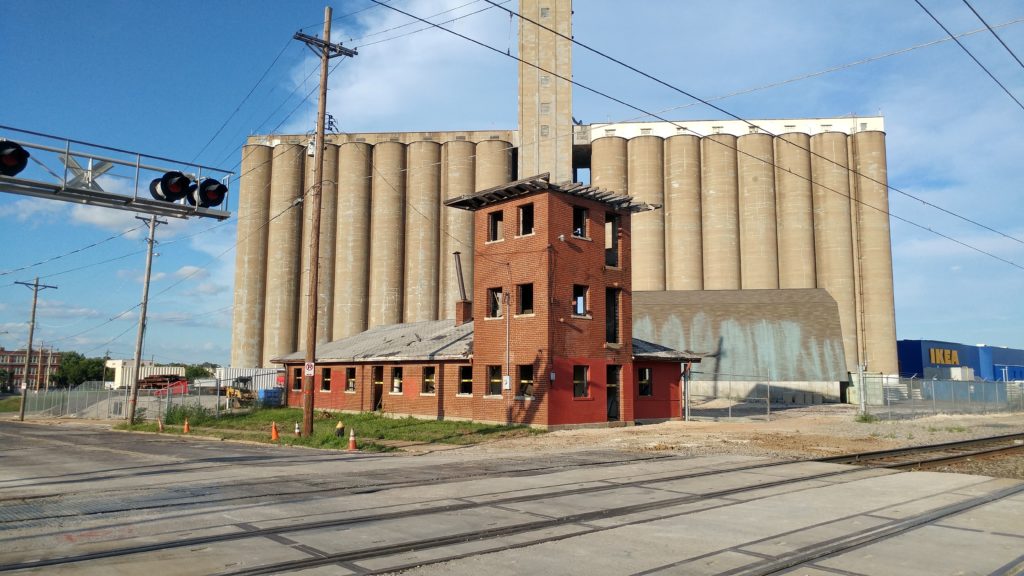
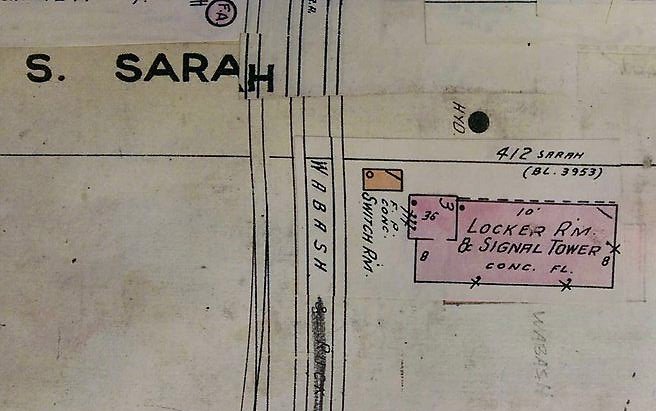
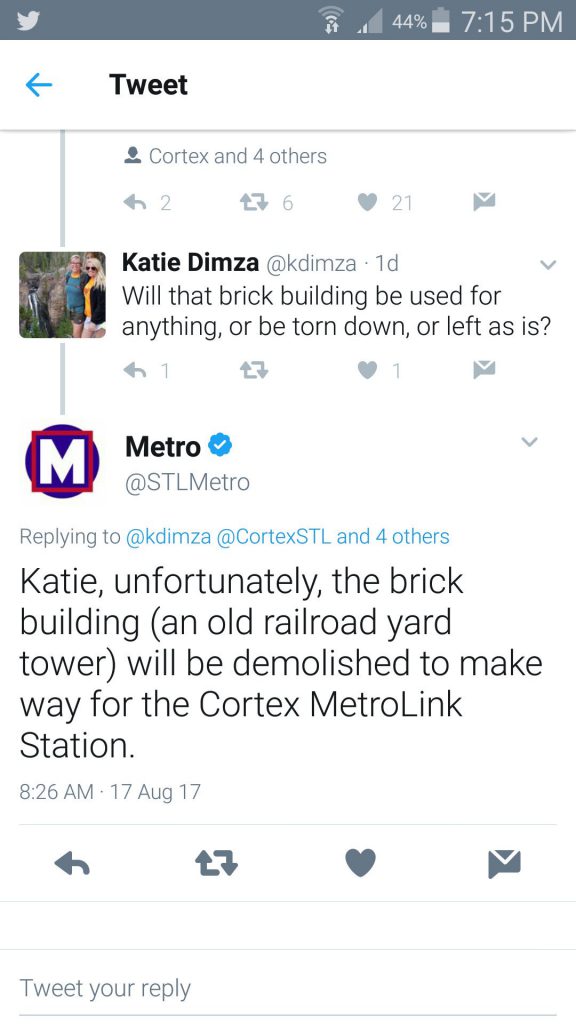
About Richard Bose
Aug 16
Everly in the Loop Photo Tour
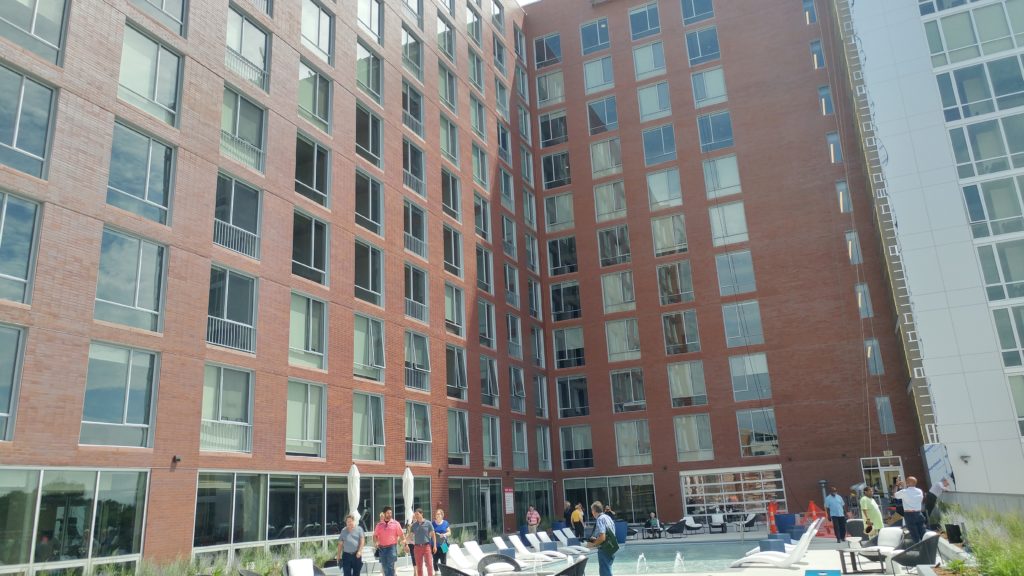
Move-ins commenced August 15 at the Everly in the Loop, a partnership between Clayco, CRG, and Koman Group, while workers put the finishing touches on the 14-story apartment building. It’ beings marketed to students, being leased by the bedroom, each with its own bathroom, and amenities and services geared towards them. Background
The apartments, with a total of 428 bedrooms, are 80% leased. The building meets the government-mandated one space per dwelling unit regulation. So far lessees have brought about 85 cars. There are also 100 spaces for bicycles. Unfortunately I couldn’t get a picture of them.
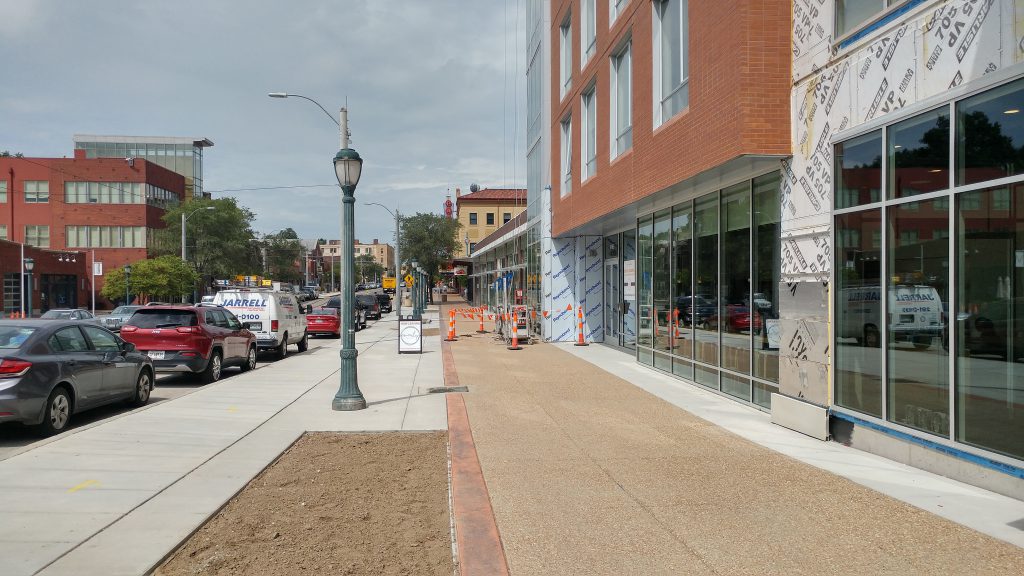 The sidewalk is open. Hope trees are coming soon.
The sidewalk is open. Hope trees are coming soon.
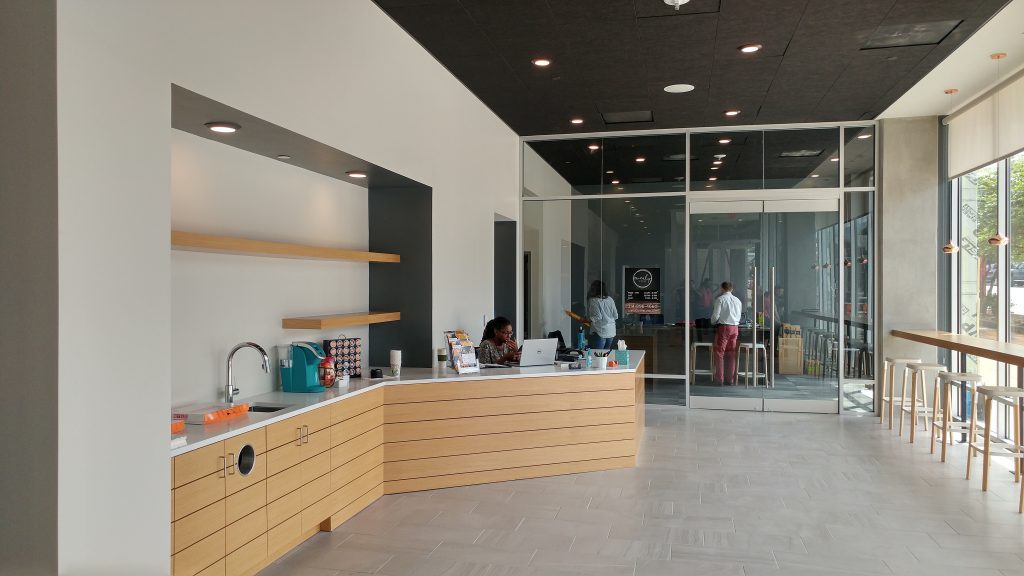
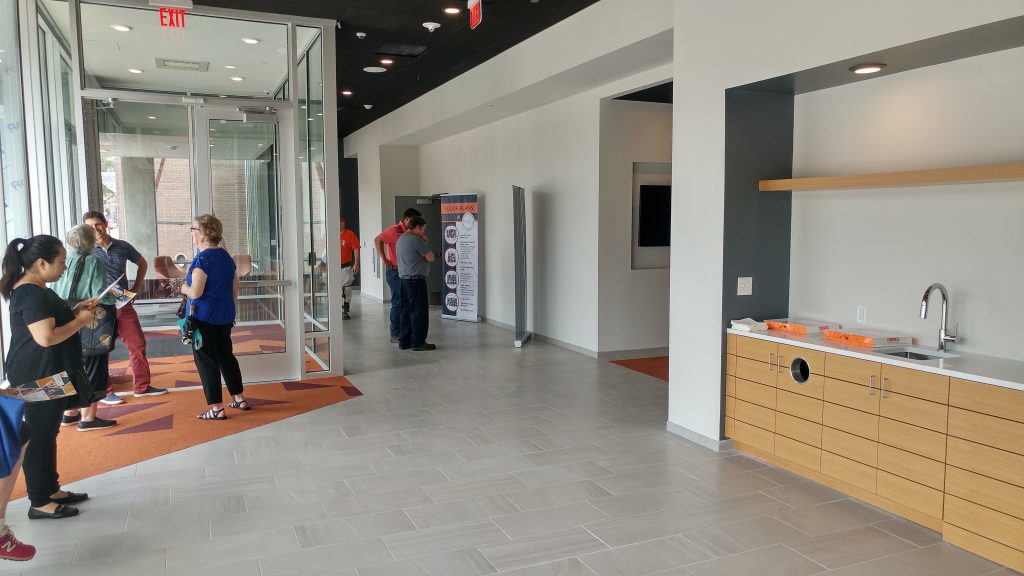 Lobby
Lobby
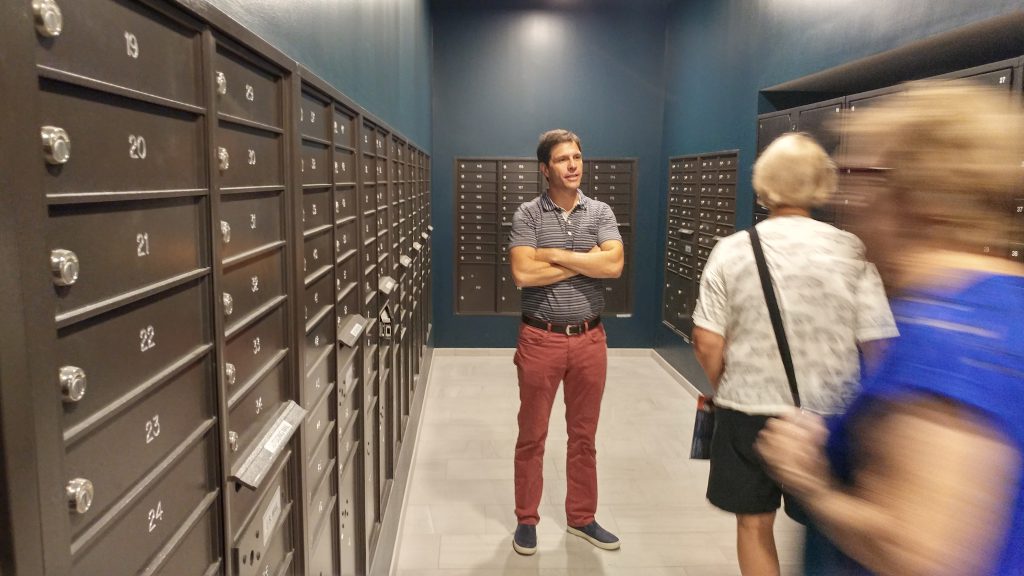 The mail room features automated package storage. A recipient will receive a text/email whenever a package arrives.
The mail room features automated package storage. A recipient will receive a text/email whenever a package arrives.
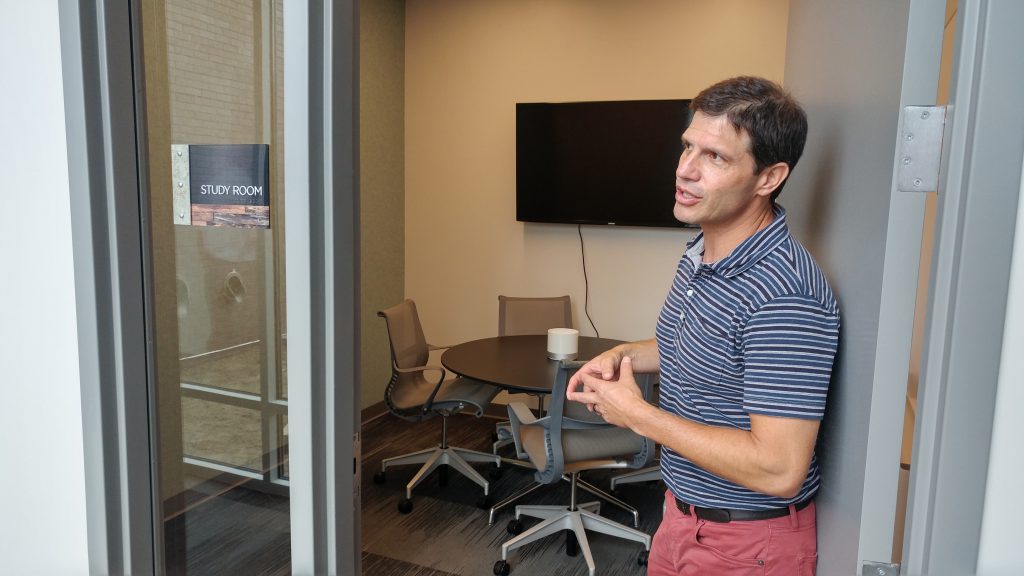 There are four study rooms.
There are four study rooms.
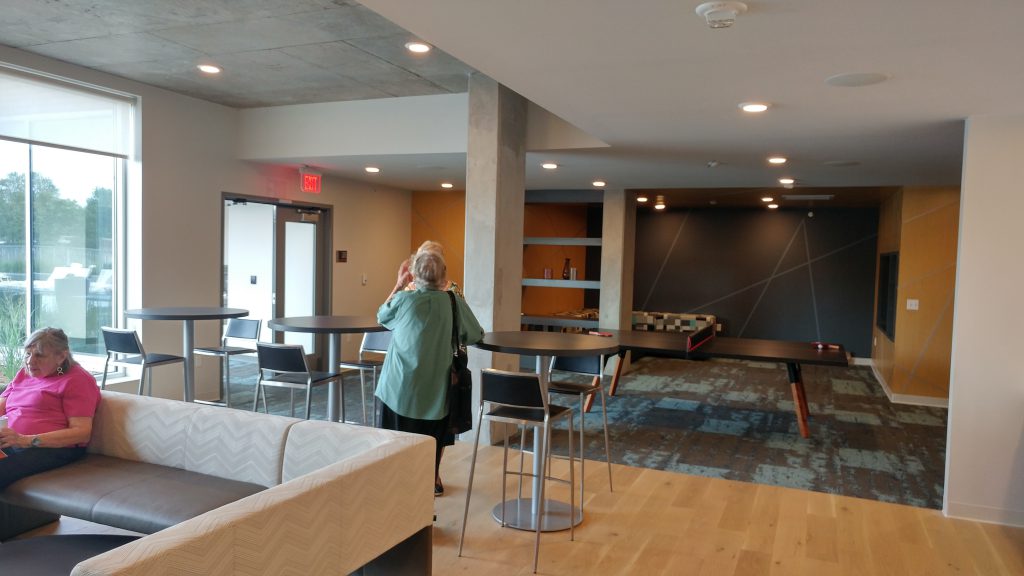 Lounge
Lounge
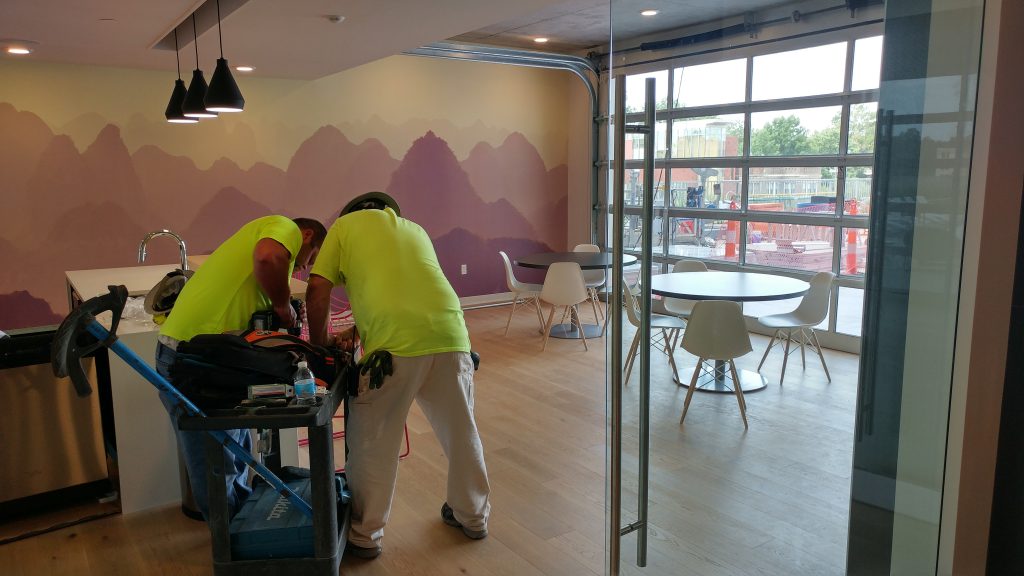
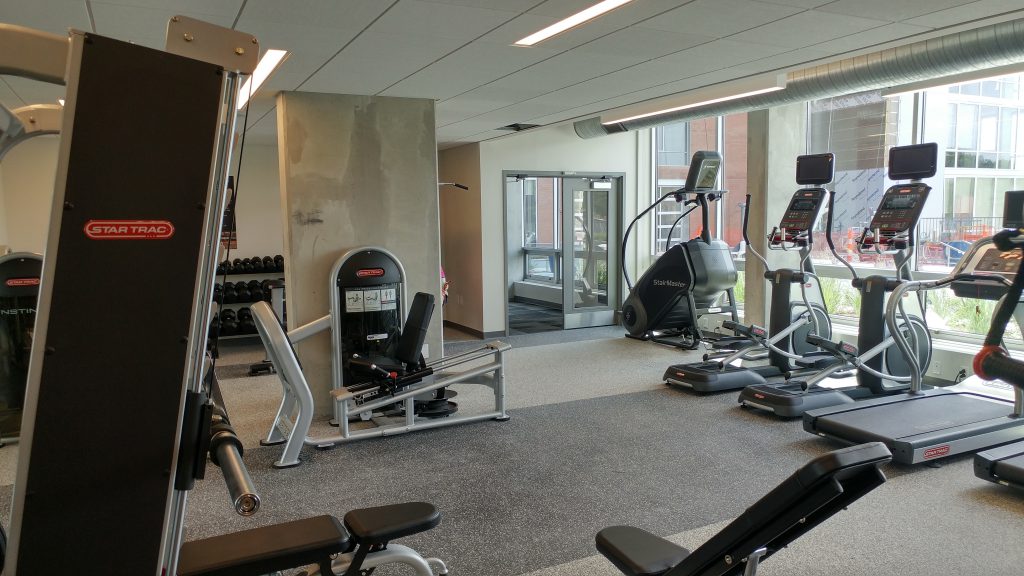 Gym
Gym
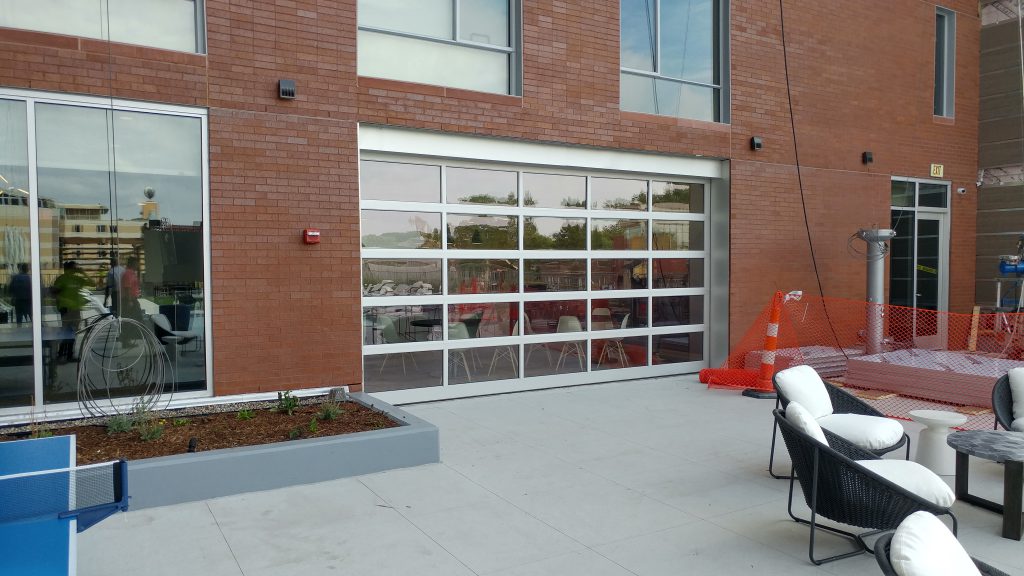
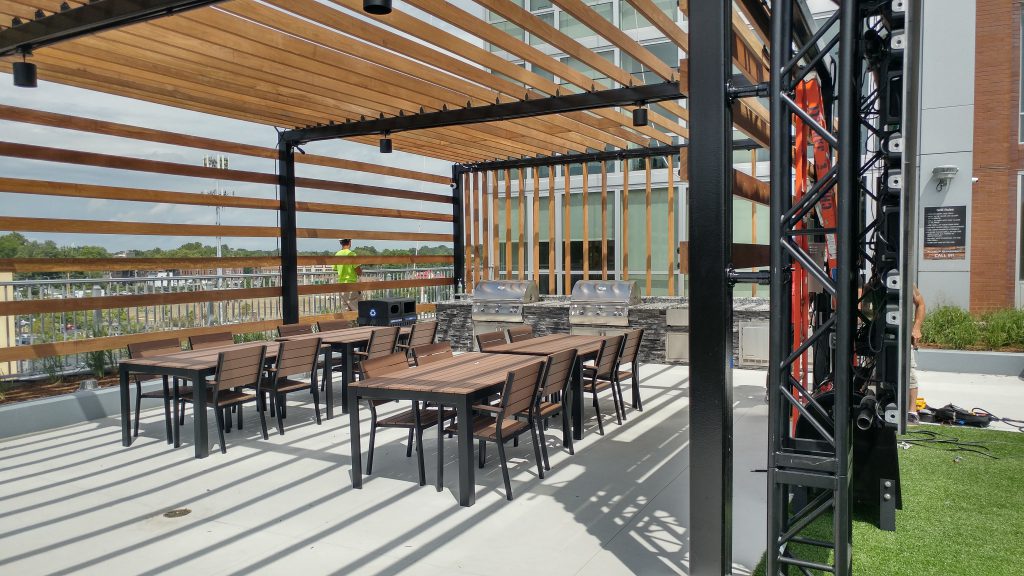
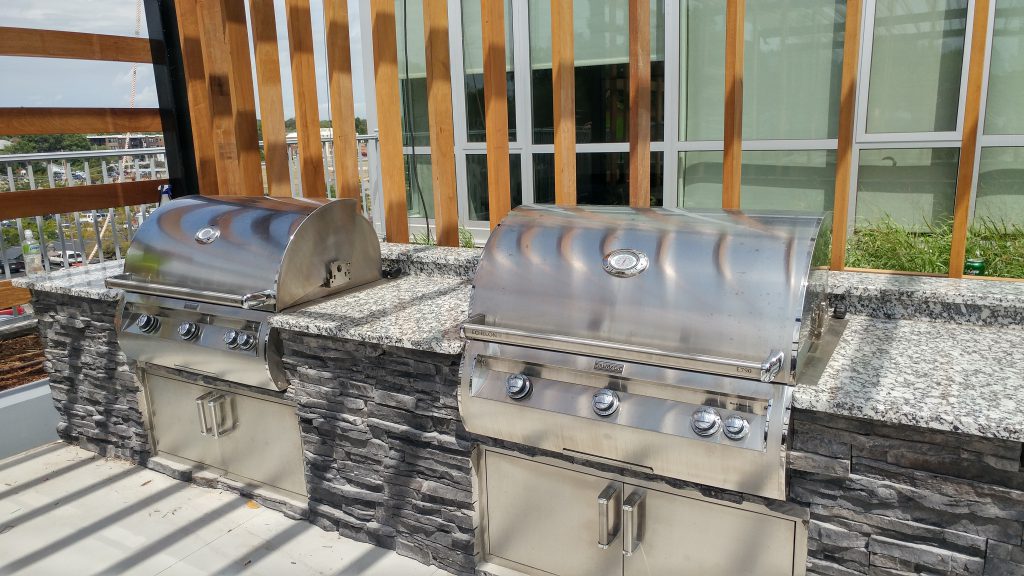
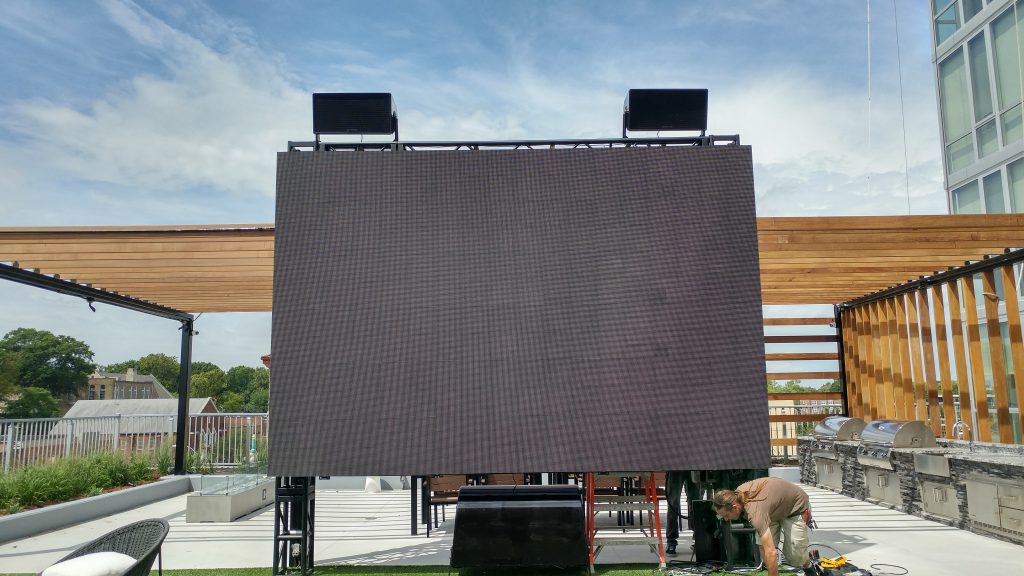 Video screen.
Video screen.
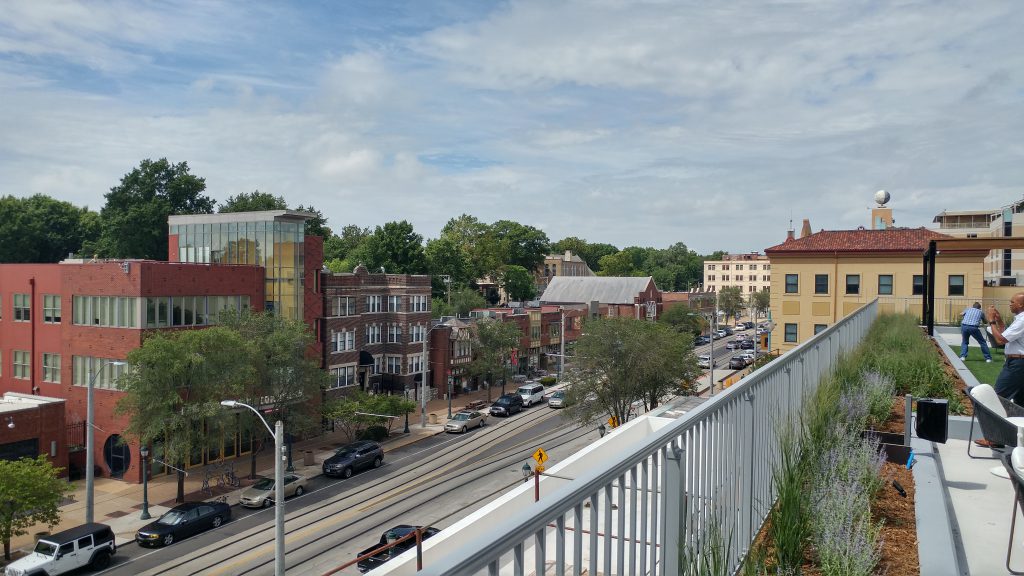
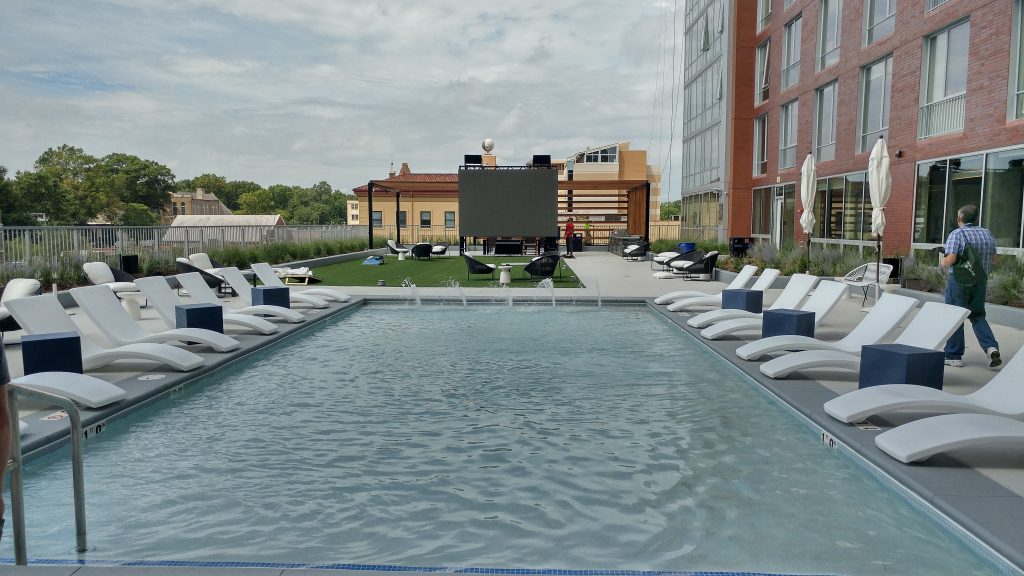 The pool is 8″ deep.
The pool is 8″ deep.
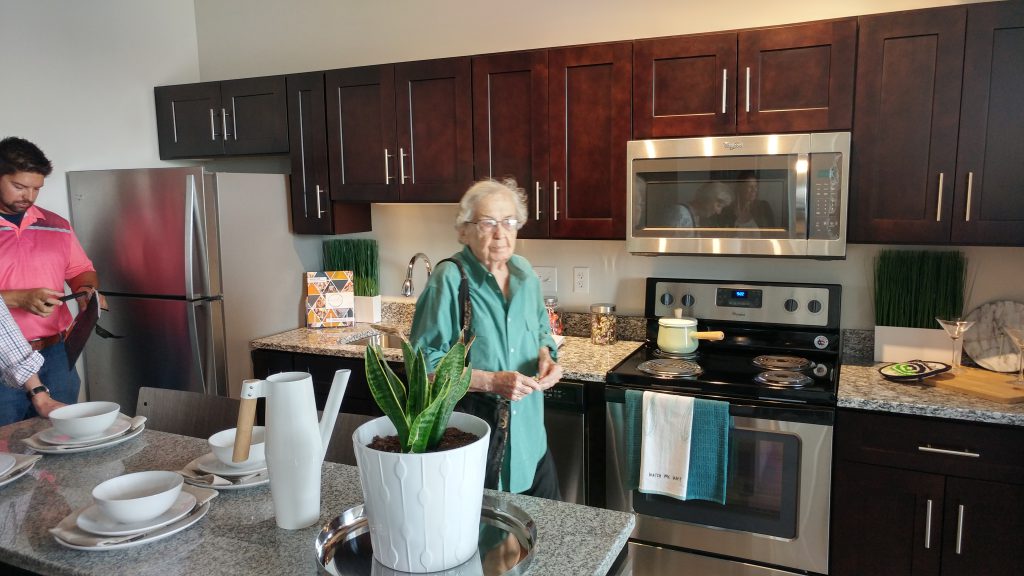 Kitchen
Kitchen
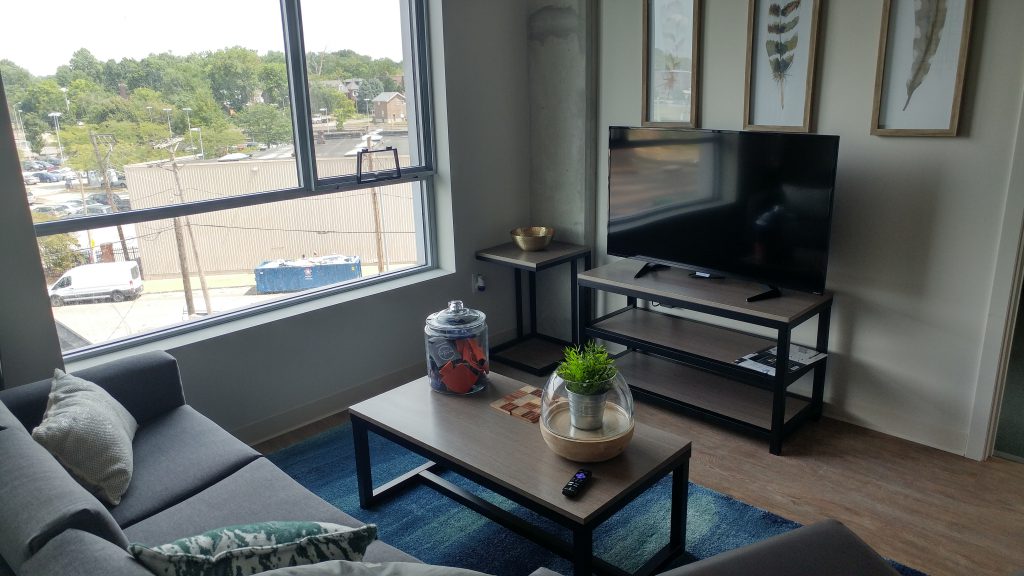 Living room
Living room
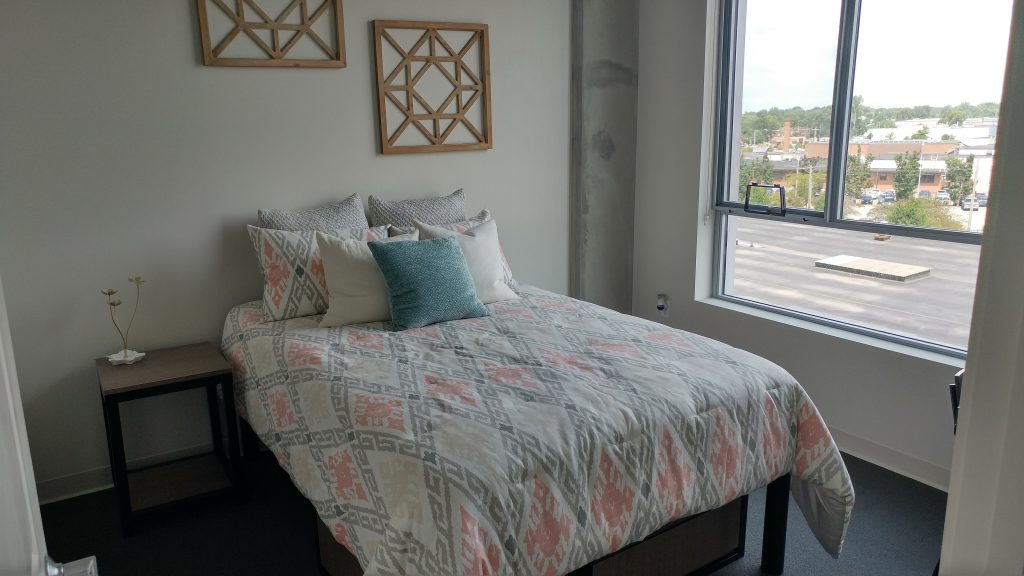 Bedroom
Bedroom
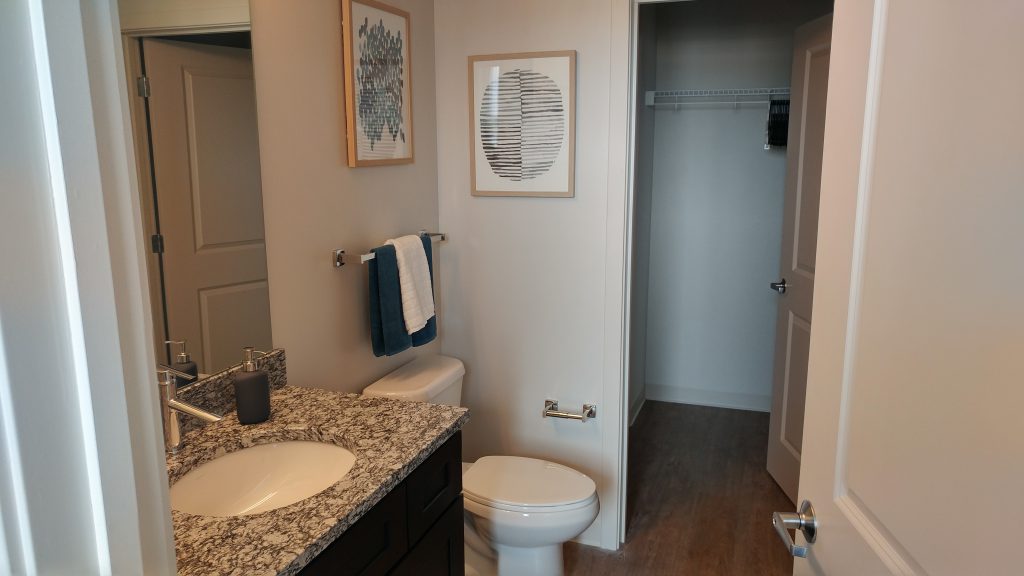 Bathroom
Bathroom
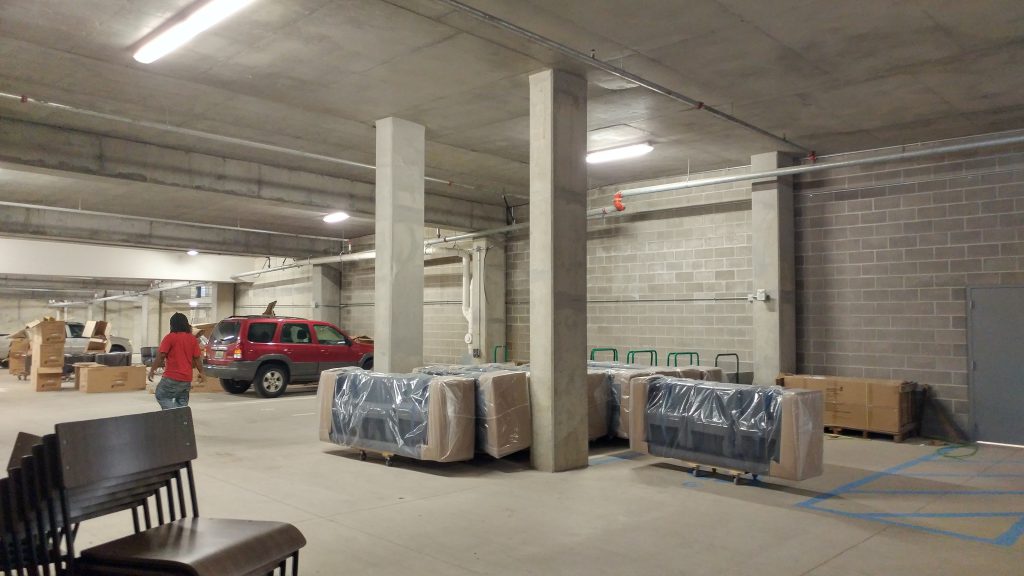 Garage
Garage
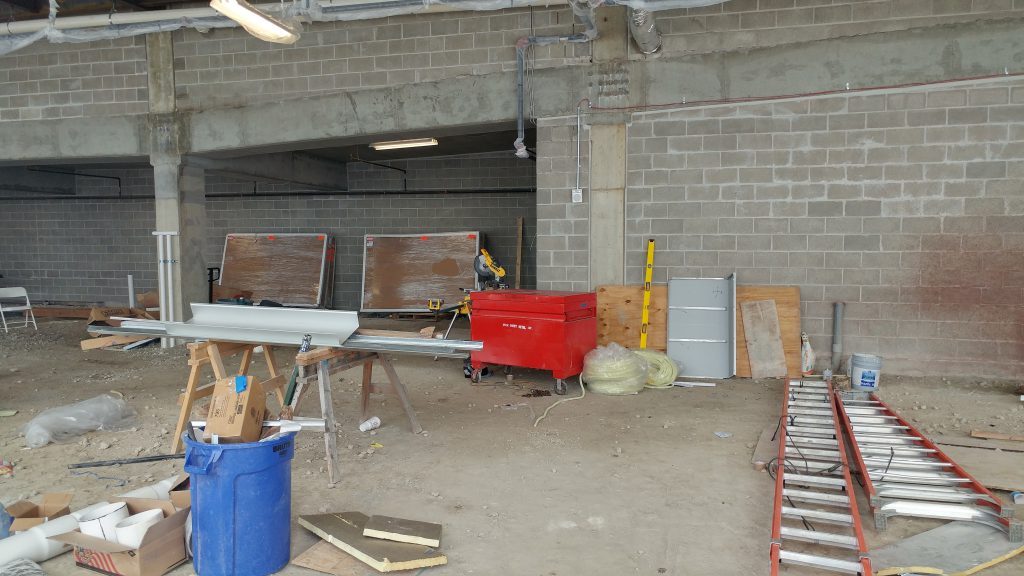 They are in talks with someone on leasing the entire commercial space.
They are in talks with someone on leasing the entire commercial space.
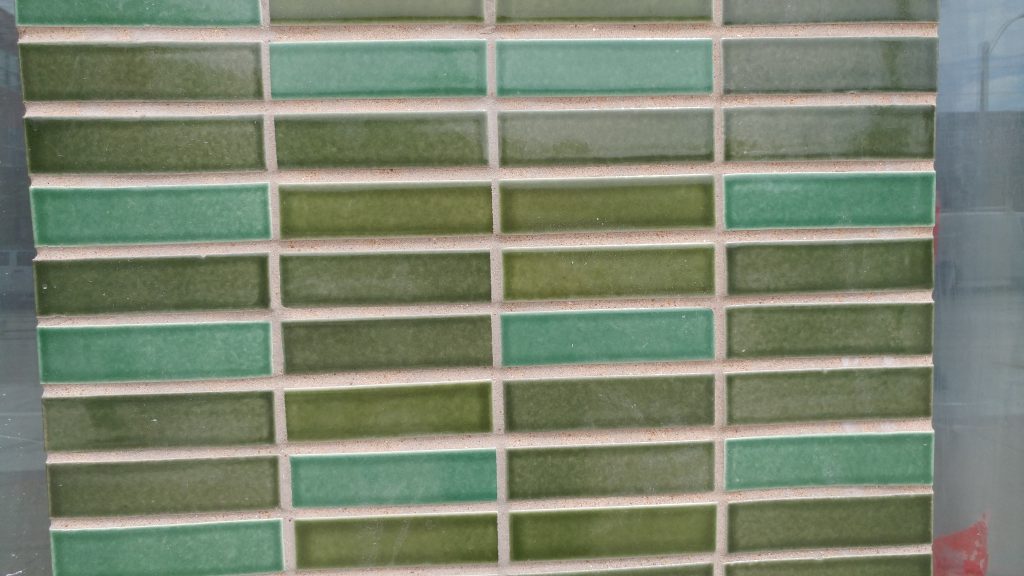 Glazed Brick.
Glazed Brick.
 Marketing flyer
Marketing flyer
About Richard Bose
Jul 10
Failure of Fragmentation: Sales Tax Hike for SLMPD

On Friday the St. Louis Board of Alderman gave first passage 20-4 to a bill to place a 0.5% sales tax increase on the November ballot. It would raise about $23M in revenue and is meant to stem compensation competition from St. Louis County and its 50+ police departments since the passage of the same tax in April. If passed, the sales tax at a restaurant in the Delmar Loop would be 13.3%.
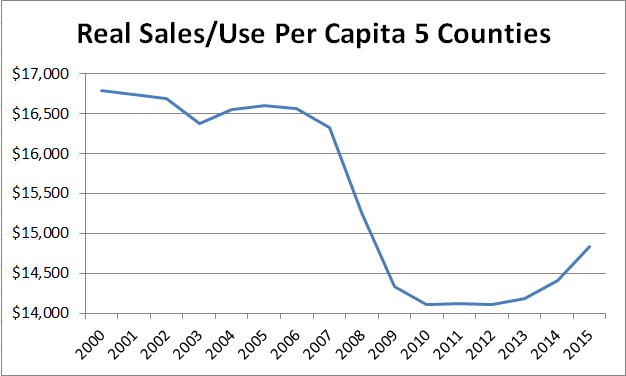
Once again we see how fragmentation and spread-out auto-oriented development patterns are leading to insolvency, adding pressure to raise taxes at every opportunity. What happens when we run out of taxes to raise? What happens when the additional pension burden comes home to roost? What happens when the sales tax house of cards collapses in the next recession?
Our broken system keeps looking inside the box and taking out the same old prescriptions. Maybe this time it will work. I’m doubtful. We should say no to tax increases and demand consolidation to free some of the $100Ms thrown away each year on fragmentation.
About Richard Bose
Jul 07
Failure of Fragmentation: Aug 8 Tax Hikes On St. Louis County Ballot

Another election is coming up (a special one at that) and that means more tax increases on the ballot to prop up fragmentation in St. Louis County. The April 2016, August 2016, November 2016, and April 2017 ballots included several tax increases and bond issues. The next ballot looks much the same.
Fragmentation and low-productivity auto-oriented development patterns are synergizing in the St. Louis area, driving up the per capita cost of government services, transportation, infrastructure, and utilities. Despite $100Ms in opportunity costs and a soft tax base under our current approach, municipal leaders are thinking inside the box to keep their budgets balanced. There are no mergers or disincorporations on the ballot.
- Bel-Ridge (Pop. 2,724)- Authority to levy a parking license fee tax up to $15 per space (not a bad idea everywhere!)
- Bel-Ridge (Pop. 2,724)- Authority to levy up to 0.65 (currently 0.35) per $100 assessed on commercial property
- Overland (Pop. 15,985)- increase the property tax rate from $0.12 to $0.24 for residential, from $0.12 to $0.36 for commercial, and from $0.12 to $0.36 for personal property per $100 of assessed value
- St. Ann (Pop. 12,971)- A Transportation Development District (TDD) for the entire city with a sales tax increase of 1%
St. Ann (and Crestwood) used to be a winner in the sales tax chase. The city relied upon shoppers from outside the city to pay sales taxes for decades. Since Northwest Plaza closed the math doesn’t work anymore. It may never work given its low-productivity spread-out development pattern. The city tried to make up for the losses with traffic tickets (Fine and fee revenues soared from less than $1M in 2009 to $2.6M in 2014). Voters passed a property tax increase to the maximum allowed amount in April by 21 points. Maybe this time it’ll be enough.
We’ve set up a scheme resembling Enron-style accounting where debt and liabilities are hidden in subsidiaries (municipalities). Those liabilities are piling up, and we pretend they will be confined to those municipalities forever. Do we let the system unravel on its own where munis hold on until the bitter end and dump those liabilities onto the county or do we come together before the bill gets even worse?
August 8, 2017 St. Louis County Sample Ballot
About Richard Bose
Jul 03
What Should Be: Delmar and SKinker
The Ferris wheel idea is dead. So What should be at Delmar and Skinker? Another auto-oriented fast-food joint a la Taco John’s? A parking lot? A traditional building?
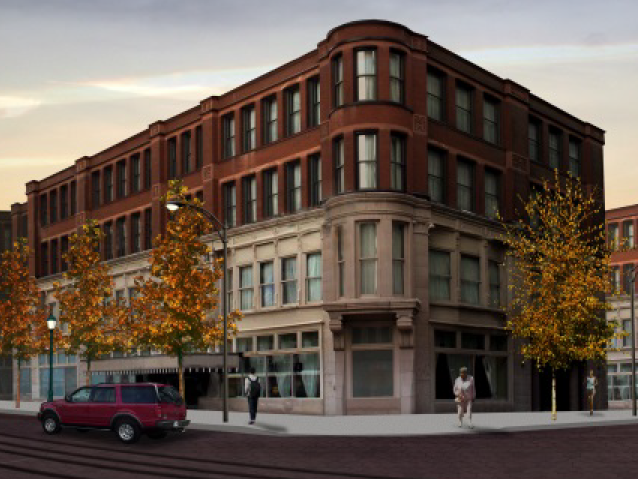 {H3 Studio}
{H3 Studio}
The Skinker DeBaliviere Neighborhood Plan calls for a mixed-use building much like that adorns the rest of the Delmar Loop. The proposed form-based code in the TOD Plan for the Delmar Loop and Forest Park DeBaliviere Metrolink Stations placed the parcel in the Boulevard Type 2 category, with heights of 3-12 stories and 40 to 130 feet. The FBC would set no parking minimum.
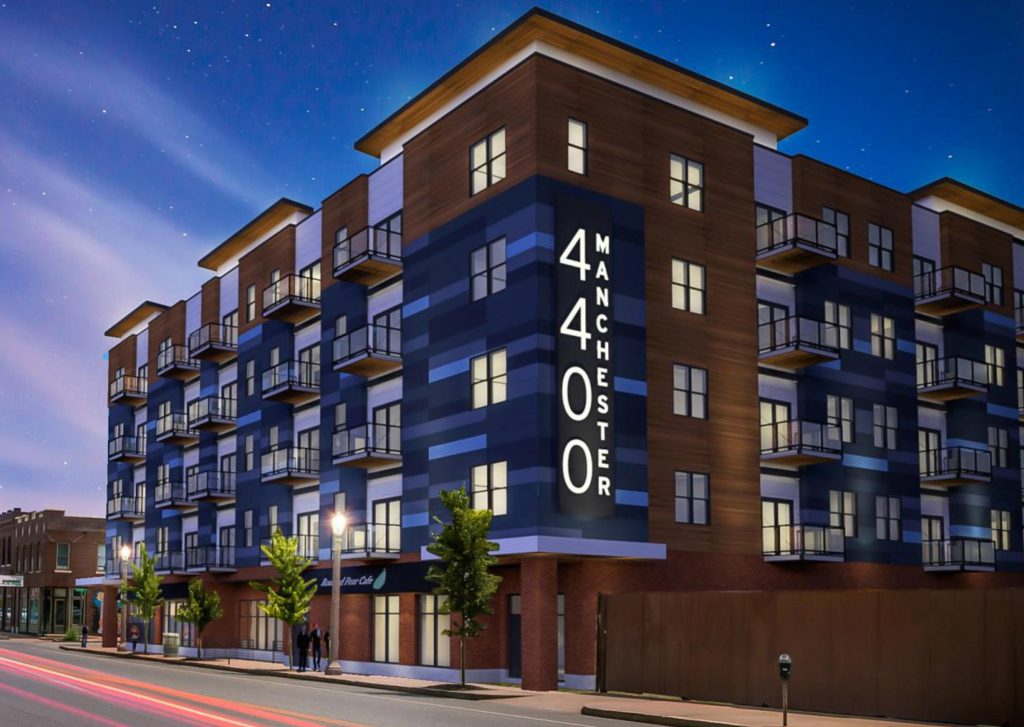 {The lot is about as big as 4400 Manchester}
{The lot is about as big as 4400 Manchester}
The parcel is currently zoned F. Neighborhood Commercial with height limit of 3 stories or 50 feet. Parking minimums are:
Office Uses:
7,500 SQ FT: One (1) Space Per 1,250 SQ FT in
Excess of the 7,500 SQ FT
Primary Retial Uses:
3,000 SQ FT: One (1) Space Per 700 SQ FT in
Excess of the 3,000 SQ FT
Residential Uses:
One (1) Space Per Dwelling Unit
Secondary Retail Uses:
7,500 SQ FT: One (1) Space Per 1,250 SQ FT in
Excess of the 7,500 SQ FT
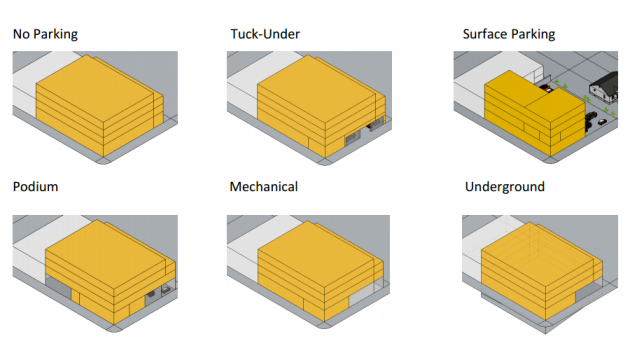 Apartment Blockers – Parking rules raise your rent
Apartment Blockers – Parking rules raise your rent
Meeting current height and parking regulations, I could fit 25 apartments, 5000 sf of retail space, and 31 parking spots. An elevator and ground-floor apartments are included because the neighborhood plan identifies senior-compatible housing as a need in short supply.
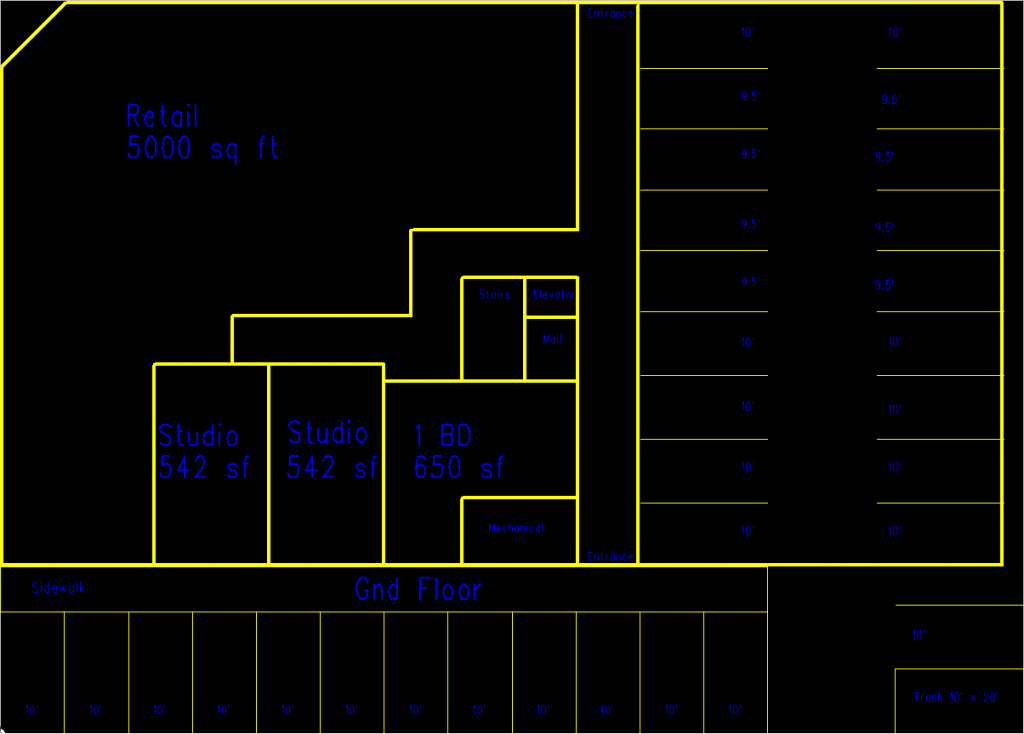 Some parking would be within the building.
Some parking would be within the building.
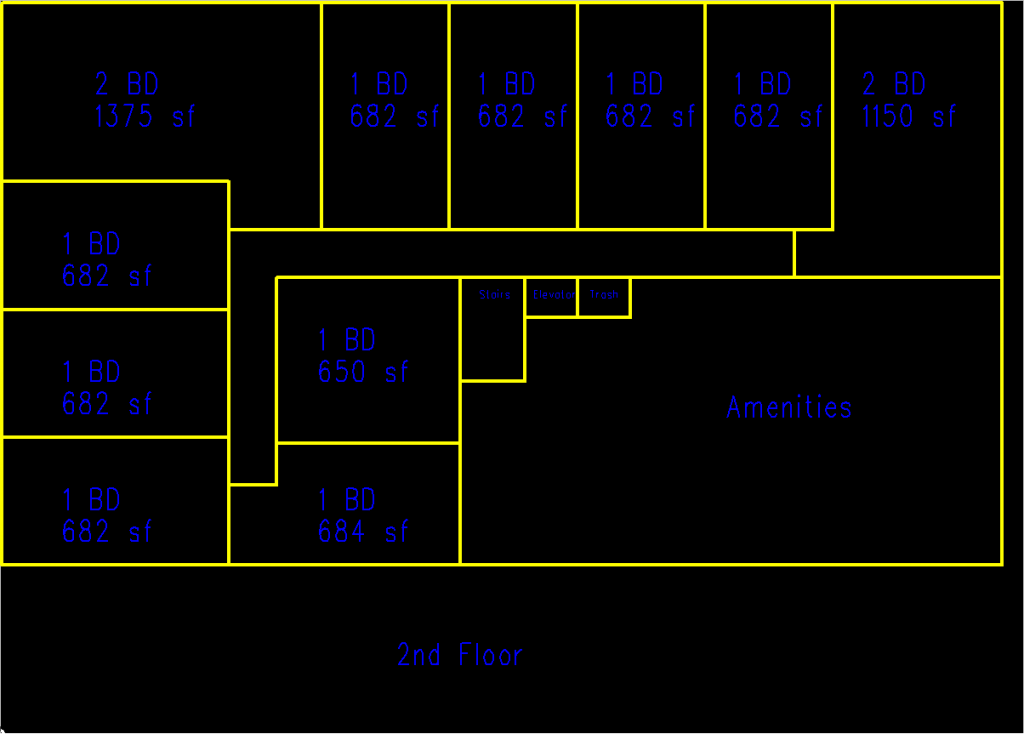
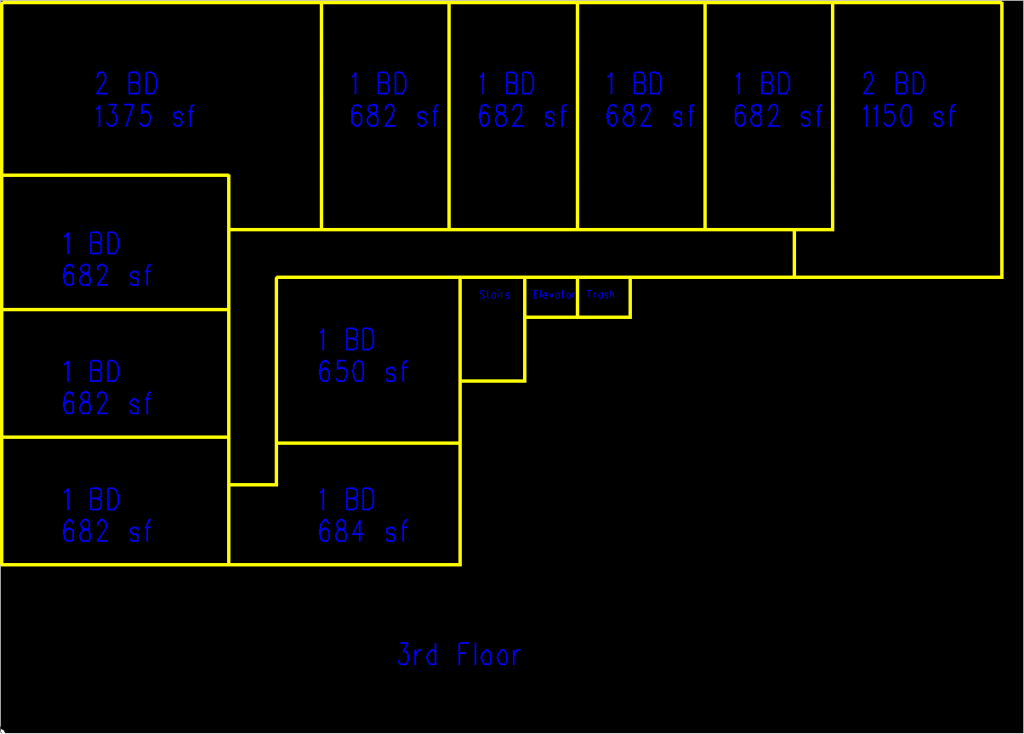
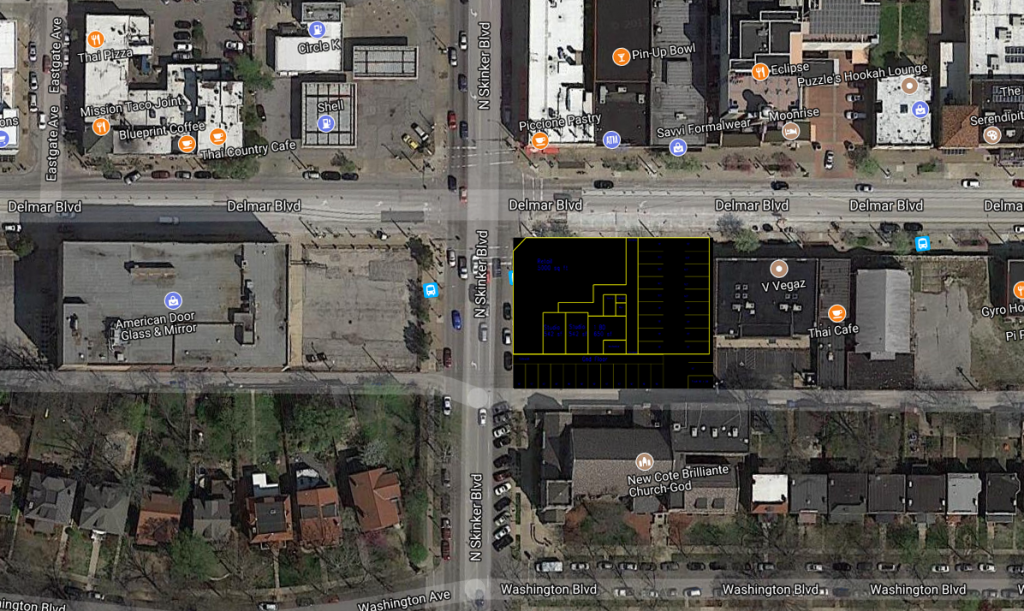
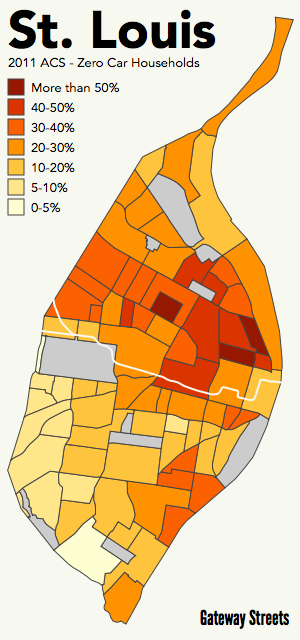 If we can get over our parking fetish and not take the government-mandated requirements as sacred, we can go taller, making the land more productive, thus increasing further the tax base without increasing tax rates to help make the city solvent. And more people living in the neighborhood means more to patronize local businesses without bringing a car. Four stories- 36 apartments, 0.78 parking spots per dwelling unit. Five stories 47 apartments, 0.53 parking spots per dwelling unit. I wouldn’t go above five so as to not dwarf the New Cote Brilliante Church next door.
If we can get over our parking fetish and not take the government-mandated requirements as sacred, we can go taller, making the land more productive, thus increasing further the tax base without increasing tax rates to help make the city solvent. And more people living in the neighborhood means more to patronize local businesses without bringing a car. Four stories- 36 apartments, 0.78 parking spots per dwelling unit. Five stories 47 apartments, 0.53 parking spots per dwelling unit. I wouldn’t go above five so as to not dwarf the New Cote Brilliante Church next door.
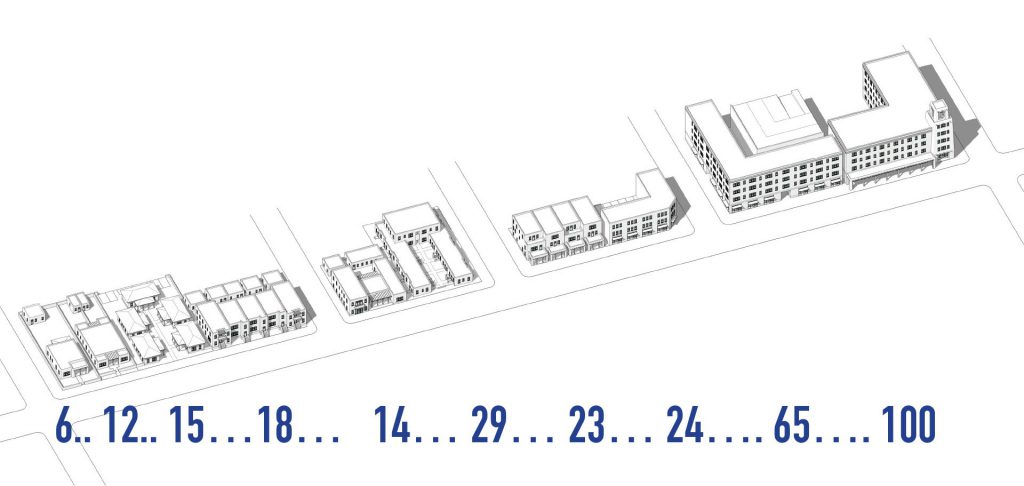 {From Greater Central Avenue Albuquerque}
{From Greater Central Avenue Albuquerque}
Assuming one person per bedroom, the three-floor configuration is at 69 people per acre, four-floor 100 per acre, five-floor 131 per acre. In order for the city’s population to be 600,000, its land must average 15 people per acre.
That’s my vision, what do you think should be at Delmar and Skinker?
Jun 26
Three Townhome Projects Continue Historic St. Louis Infill Trend
We’re big fans on infill townhomes in St. Louis. The relative density of these projects, large and small, fits well in the historic scale of much of the city. Townhomes present a so-called gentle density, adding more residents to the city without introducing large apartment buildings. And the economics are smart for the city as well, as property tax revenue per acre is significantly greater with townhomes than single-family dwellings.
Two three-unit projects in Soulard and two two-unit townhomes in the Fox Park neighborhood look to continue this trend. All are located in local historic districts and so are reviewed by the city’s Cultural Resources Office and Preservation Board.
__________________________________________________________________________________________
1851 Menard Street – Soulard Historic District
OWNER/DEVELOPER: JS Community Builders LLC/Justin Hemkens
ARCHITECT: Feeler S Architects
THE PROJECT: The project proposes to construct three attached townhouses with first-story garages on a vacant site on the west side of South 10th Street, adjacent to Interstate 55.
PRELIMINARY FINDINGS AND CONCLUSION: The Cultural Resources Office consideration of the criteria for new construction in the Soulard Historic District led to these preliminary findings:
- 1851 Menard Street is located in the Soulard Neighborhood Local Historic District.
- The applicant has provided an appropriate Model Example for the proposed new construction.
- The project generally complies with the requirements of the Standards to follow a Model Example except in the areas of scale and foundation material.
Based on these preliminary findings, the Cultural Resources Office recommends that the Preservation Board grant preliminary approval for the proposed new construction with the stipulation that final plans and design details will be approved by the Cultural Resources Office for compliance with the district standards.
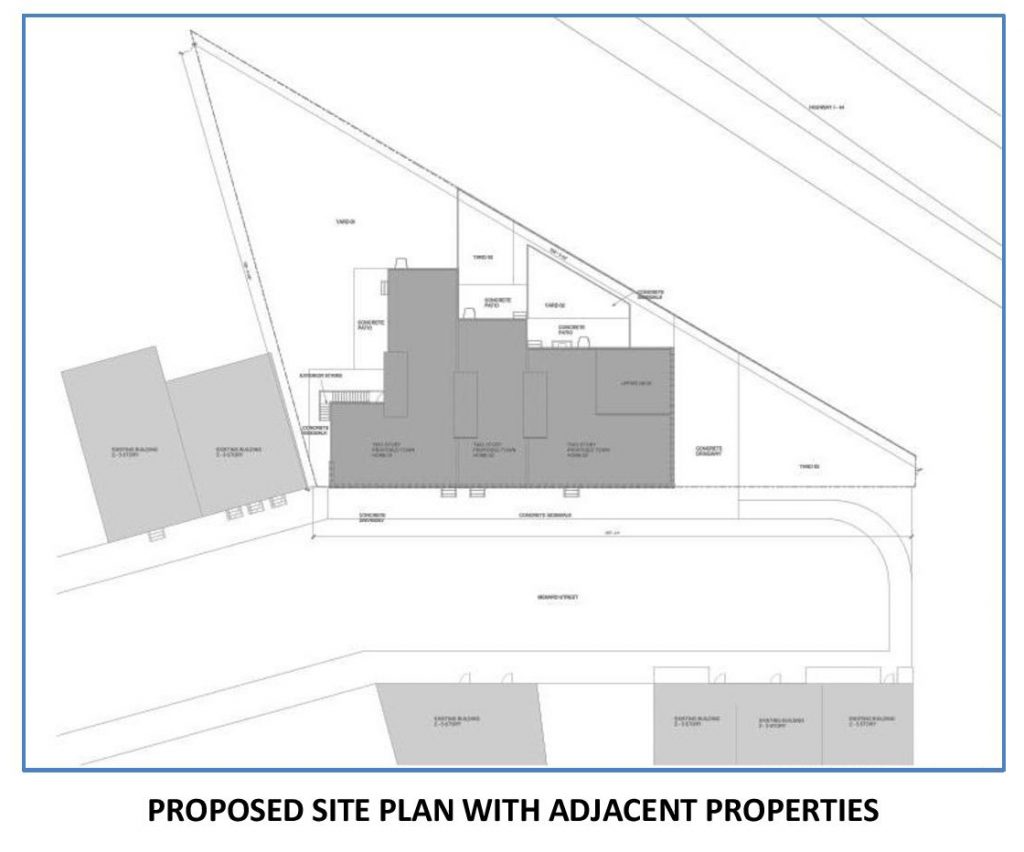
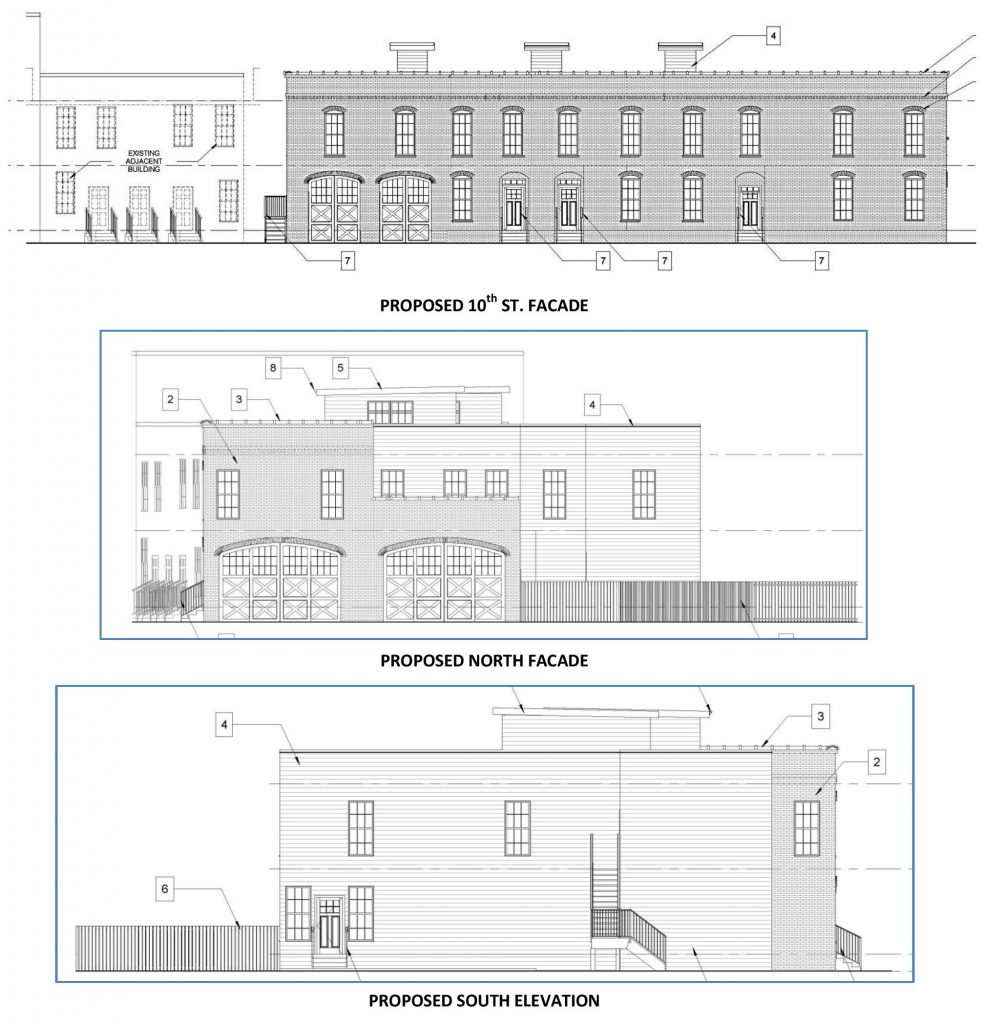
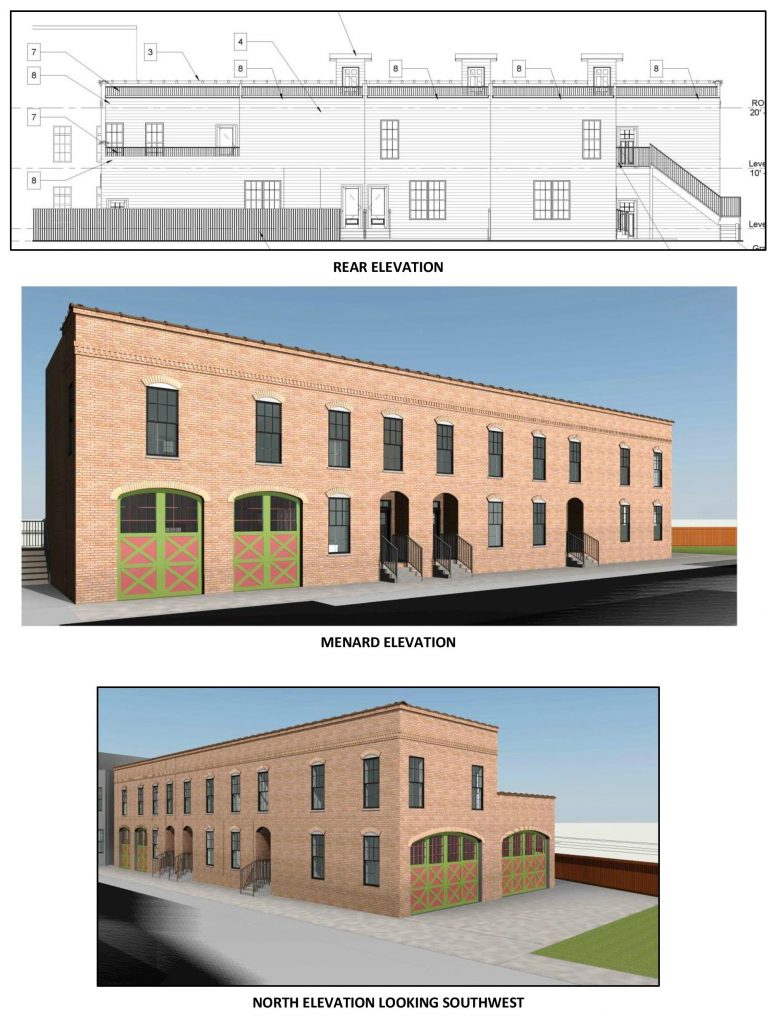
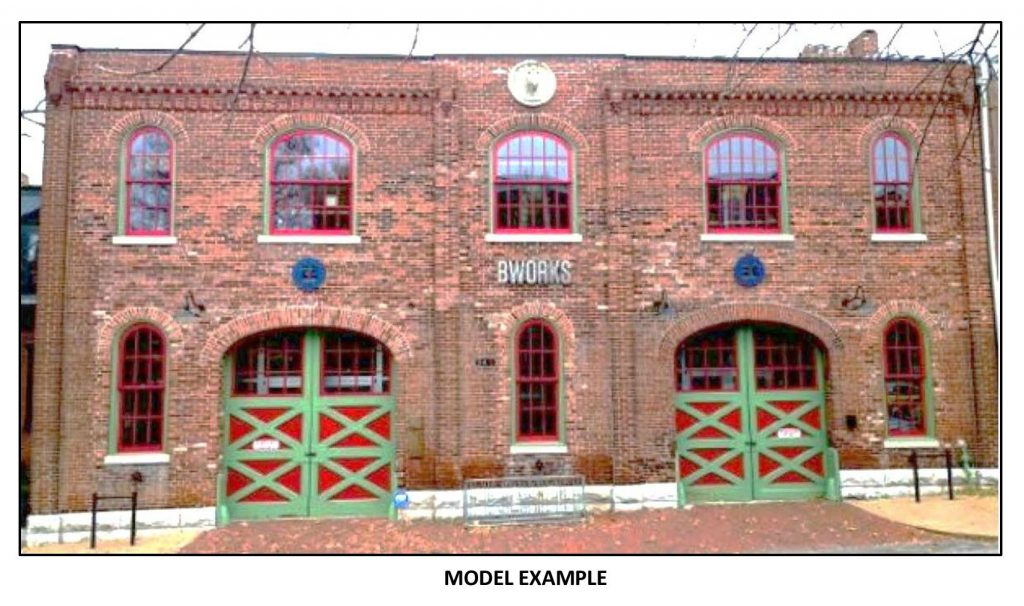
__________________________________________________________________________________________
1810 South 10th Street – Soulard Historic District
OWNER/DEVELOPER: Dan Holak
ARCHITECT: Keith Schroeder
THE PROJECT: The project proposes to construct three attached townhouses on the east side of South 10th Street on a vacant site in the Soulard Local and National Register Historic District. As a new construction project, the Cultural Resources Office scheduled it for review by the Preservation Board.
PRELIMINARY FINDINGS AND CONCLUSION: The Cultural Resources Office consideration of the criteria for new construction in the Soulard Historic District led to these preliminary findings:
- 1810-20 South 10th St. is located in the Soulard Neighborhood Local Historic District.
- The applicant has provided an appropriate Model Example for the proposed new
construction. - The proposed design complies with most of the requirements of the Soulard Historic
District standards.
Based on these preliminary findings, the Cultural Resources Office recommends that the Preservation Board grant preliminary approval for the proposed new construction with the stipulation that final plans and design details will be approved by the Cultural Resources Office for compliance with the district standards.
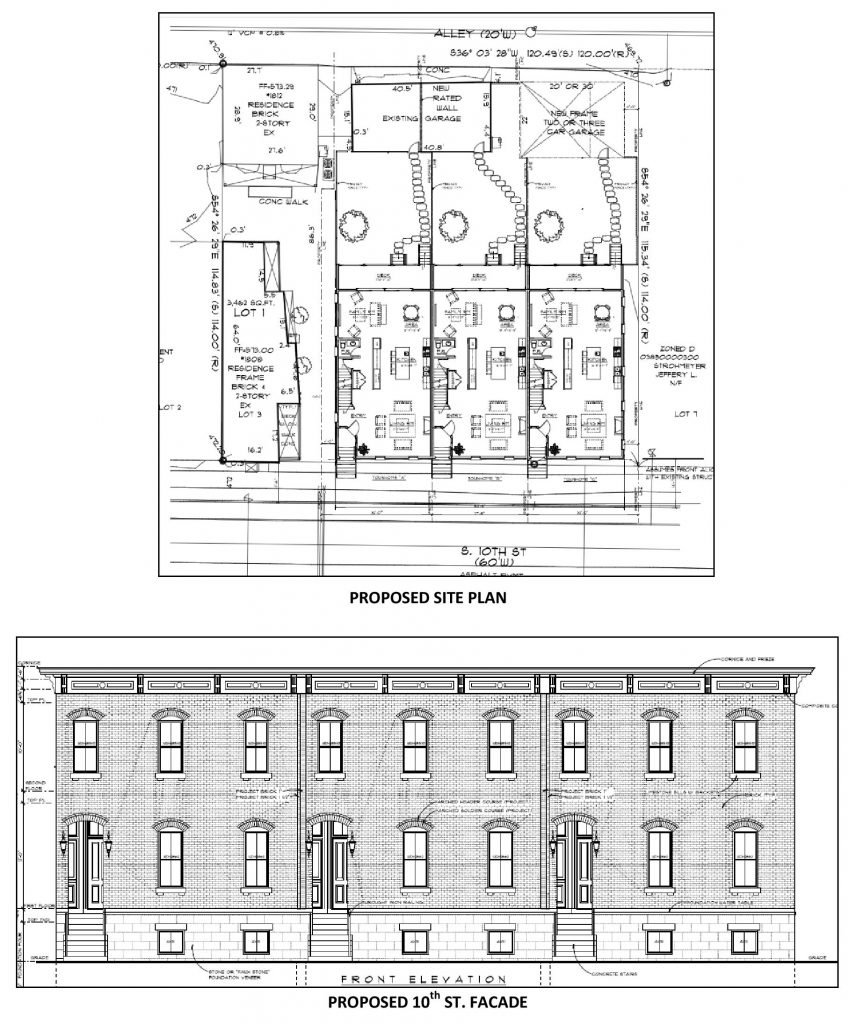
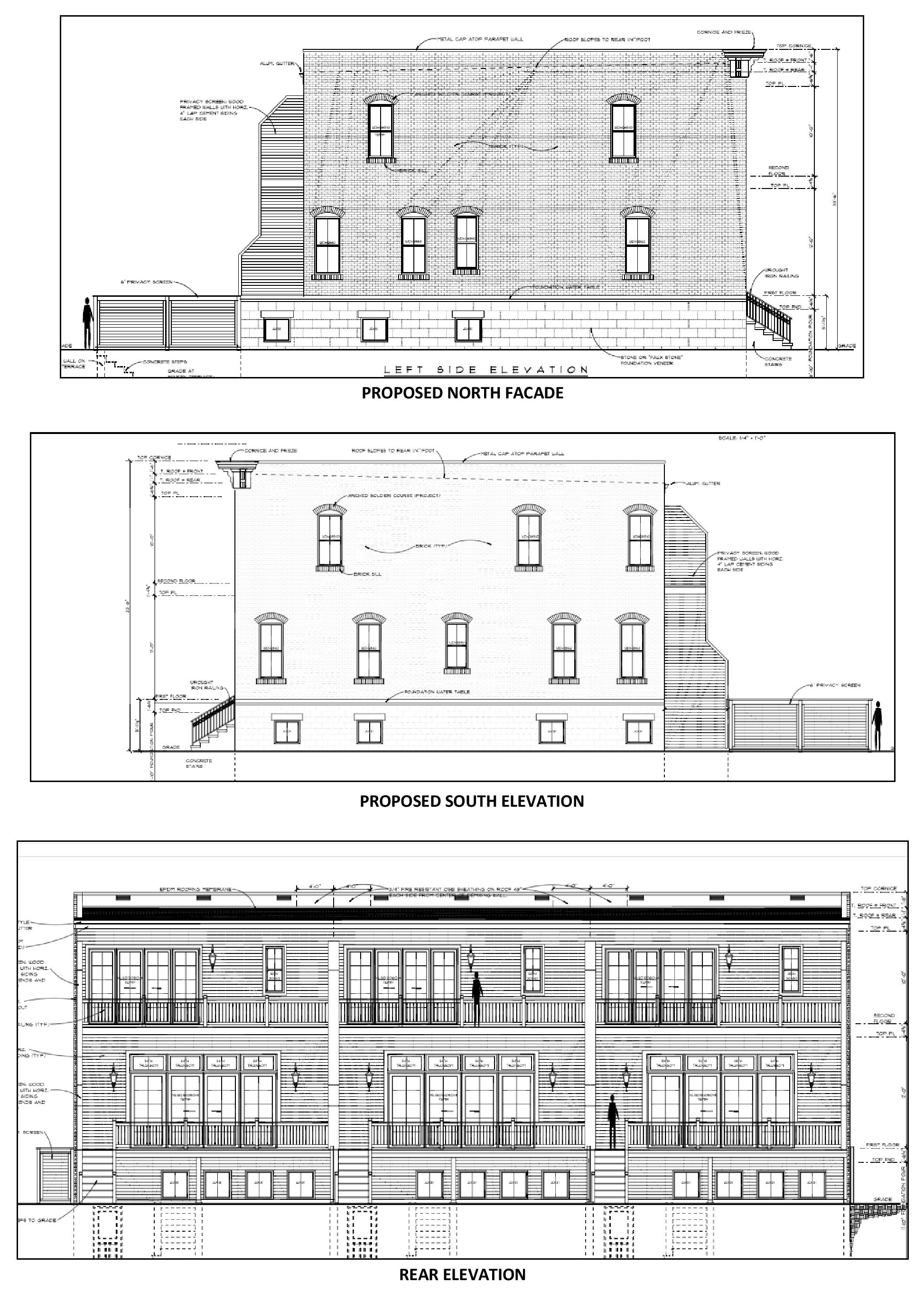
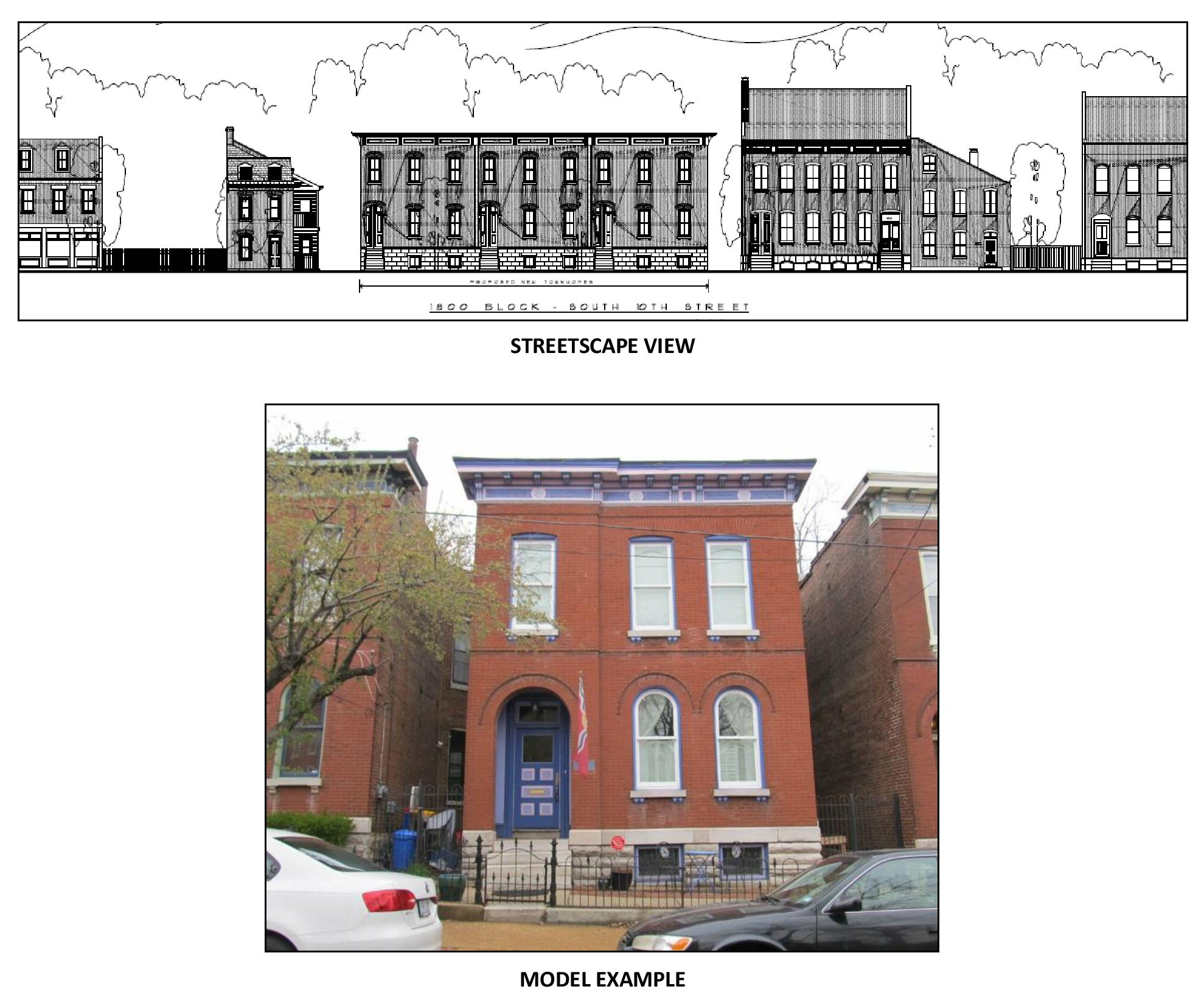
__________________________________________________________________________________________
1827 California – Fox Park Historic District
OWNER/APPLICANT: Schill Investment Fund LLC/Tim O’Donnell
THE PROJECT: The developer proposes to construct two 2-family townhouse buildings with attached rear garages on a currently vacant site at the northwest corner of Geyer and California Avenues. The property is directly adjacent to Interstate 44 at the north boundary of the Fox Park Local Historic District.
PRELIMINARY FINDINGS AND CONCLUSION:
The Cultural Resources Office’s consideration of the criteria for new fences and retaining walls in the Fox Park Historic District Standards led to these preliminary findings:
- 1827 California Avenue is located in the Fox Park Neighborhood Local Historic District.
- While the applicant has not provided a specific Model Example for the proposed new construction, the design of the proposed buildings follows historic precedent.
- The project generally complies with the Fox Park District Standards for New Construction.
- The unusual characteristics of the site, with no rear alley, require that access be provided from California and Geyer.
Based on the Preliminary findings, the Cultural Resources Office recommends that the Preservation Board grant preliminary approval to the project, subject to the stipulation that final plans and design details will be approved by the Cultural Resources Office for compliance with the district standards.
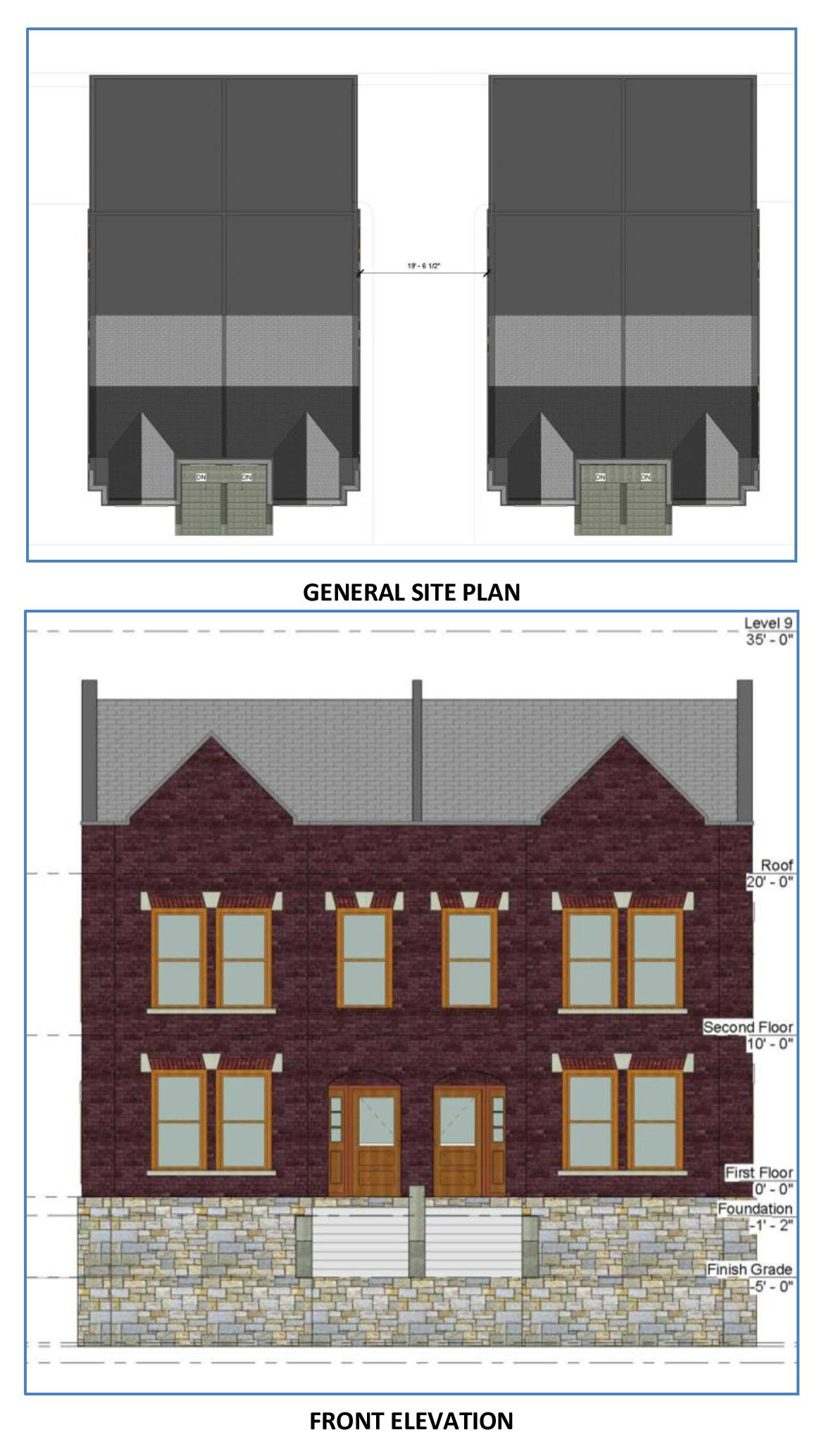
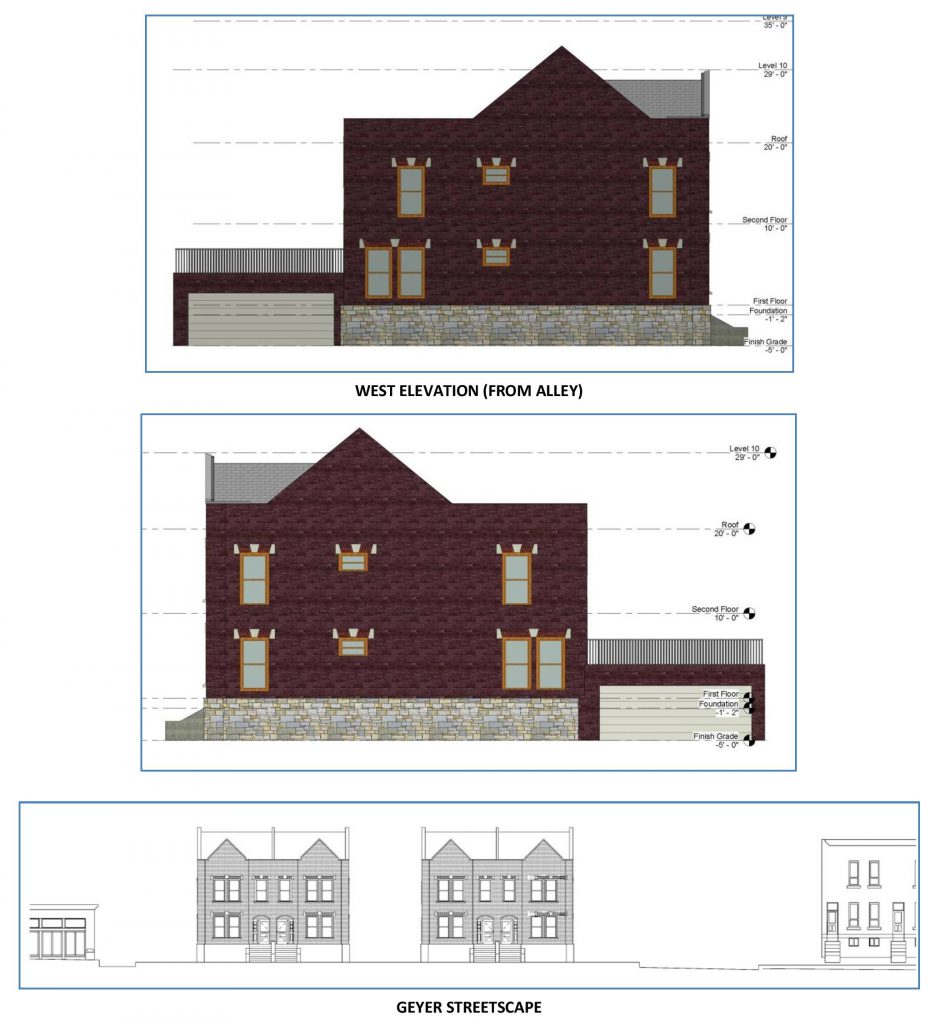
Jun 23
The Lafayette Square Neighborhood by Grain, Inc.
If you like videos of St. Louis, you’ve likely heard of Grain, Inc. Their film “Here is St. Louis” garnered a lot of well-deserved attention back in 2012. A follow-up “Here is St. Louis Two” the next year was worth watching and sharing as well. Now, Grain is turning its attention to the city’s neighborhoods. Its first neighborhood video was shot in The Grove (AKA Forest Park Southeast) – check it out here. The second neighborhood video is of Lafayette Square. A huge historic preservation success story, Lafayette Square has also seen a lot of change in recent years, with more to come.
Jun 21
The Gravois. (An Ode to a St. Louis Stroad)
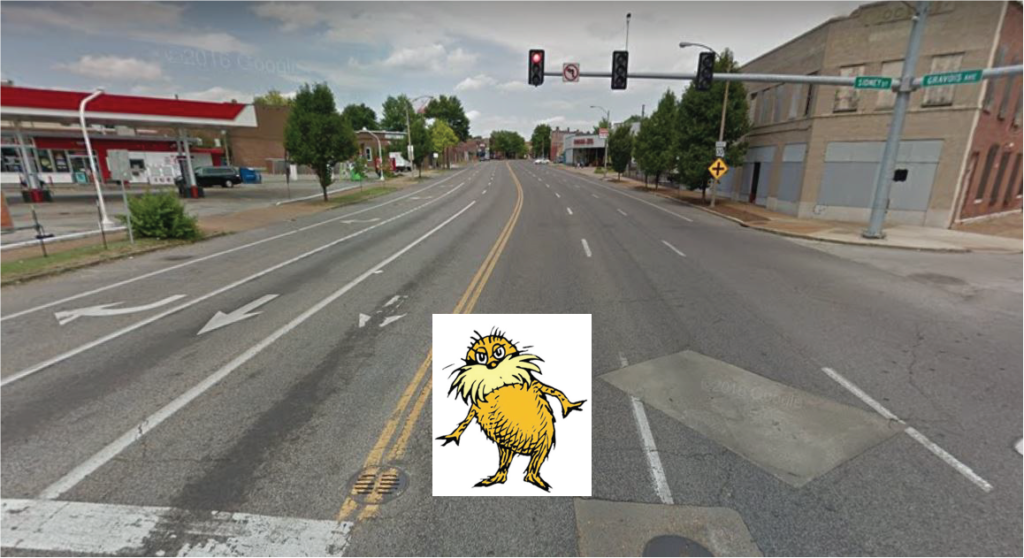
Note: This goofy poem tells the story of a very cool grassroots effort called the Greater Gravois Initiative, which advocated successfully to make Gravois road a better place for people. I highly recommend you read more on the effort here from NEXT STL.
The Gravois
On the South side of town
And curving toward West
Is a long winding thoroughfare that seldom does rest
A rumbling road that the neighbors detest.
It’s the street called the Mighty Gravois.
Now come a bit closer and sit at my knee boy
I’ll tell you the tale and I’ll make it quite quick
Of a momentous feat that few would predict
I’ll tell you the taming of the Mighty Gravois.
An asphalt behemoth, a bustling beast
Funneling cars to the North the South West and East
Like a concrete river
It carved a curved path
Through historic neighborhoods it cuts a wide swath.
And they cars they did love it
It’s not hard to see why
The street was built for their comfort
It was built six lanes wide!
So the semi-trucks trucked and the convertibles cruised
And speed limit signs were ignored and abused
Where they were going well that we don’t know
We just know they were going and they’d go go go go!
The crosswalks were few and appeared only rarely
And to try to use them could prove quite scary
Among bicyclists only the most intrepid breed
Would hazard the cars and their harrowing speed.
But one day a question came from the grassroots
From walkers who walk and scooters that scoot
From small businesses too quickly passed by
From neighborhoods split by the Gravois divide
From parents with strollers and bussers who bus
“Well why can’t this road be also for us?!?!”
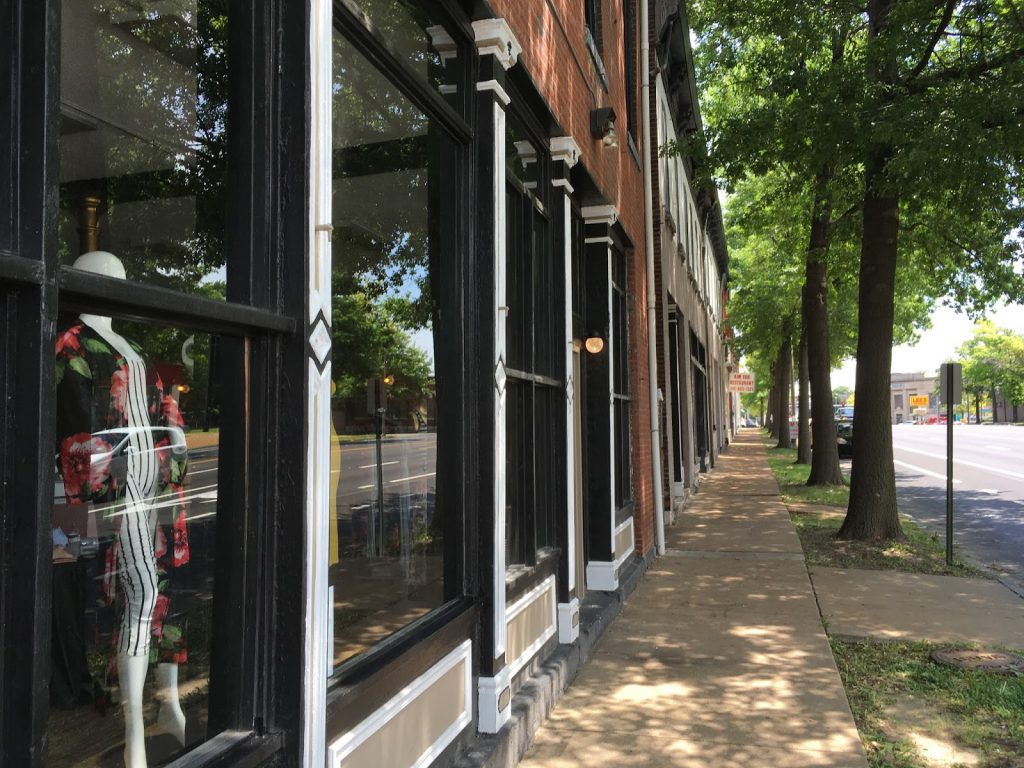
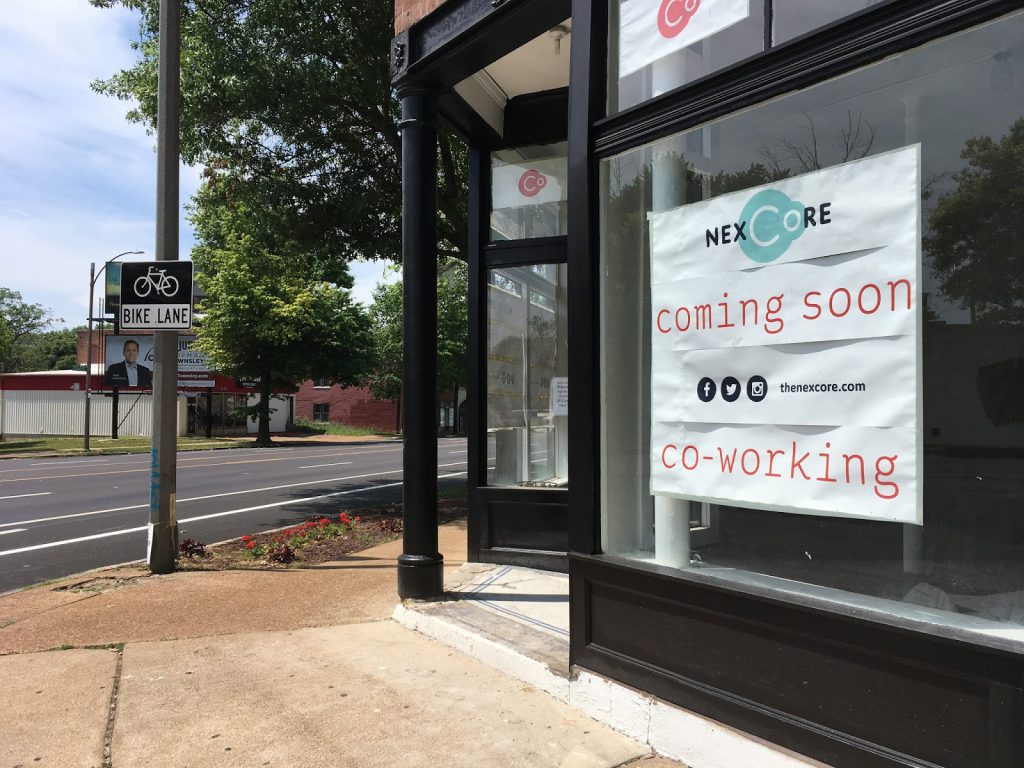
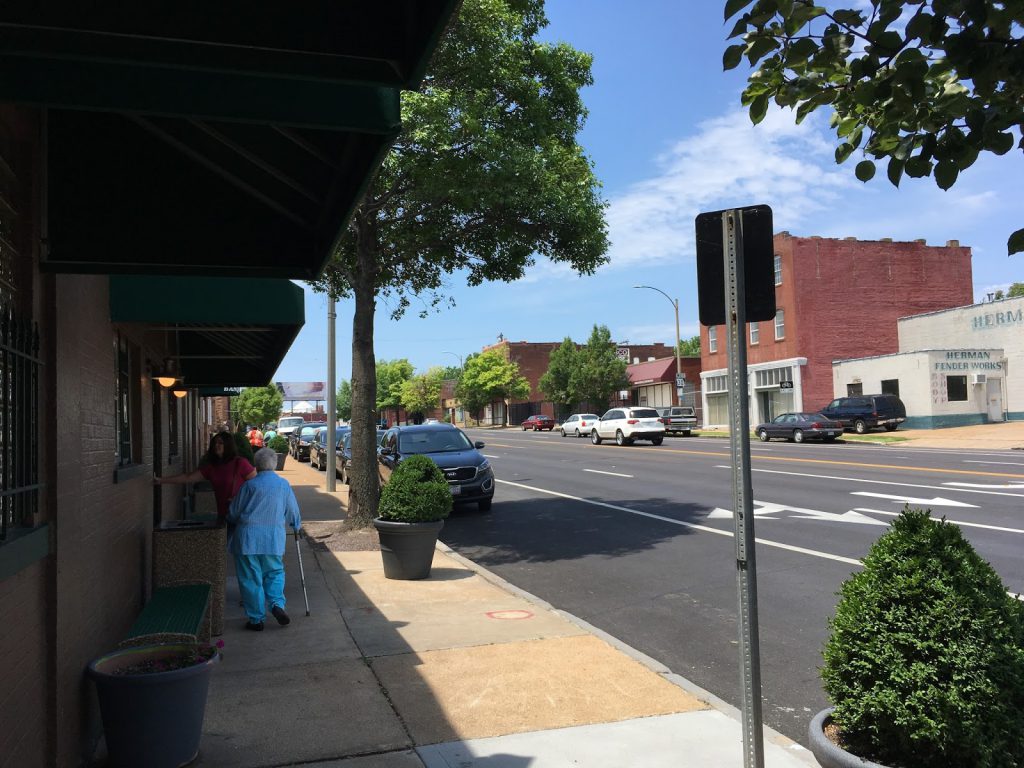 {Small businesses along Gravois. Pedestrian-oriented commercial buildings can struggle along high-speed roads.}
{Small businesses along Gravois. Pedestrian-oriented commercial buildings can struggle along high-speed roads.}
And so began efforts to create a new plan
Of crosswalks and bike lanes and places to stand
And lanes for the cars of course they’re still there
With restrictions in place that they’ll just have to bear.
Unused to this challenge oh MODOT did wail
“We’ve been trained to use hammers why can’t we just nail?”
But this broad coalition continued their stand
And re-explained concepts like induced demand.
And against all odds a new road appeared
And showed that MODOT overcame their old fears
A road on which people can walk, bike, and survive
Restricted from six lanes, it now counts just five!
Grumps predicted confusion and traffic kerfuffles
And cars moving along at barely a shuffle
But to their surprise if not their delight
Even at rush hour the cars are alright.
Sure, it could be better I have to admit
The bike lanes often just suddenly quit
Car speeds are still reckless especially at night
But the improvement is major not merely just slight.
So heed my words now that I’ve told you this story
The champions for change have sure earned their glory
It’s cause for celebration but there’s no time for rest
We’ve tamed the Mighty Gravois now which road is next?
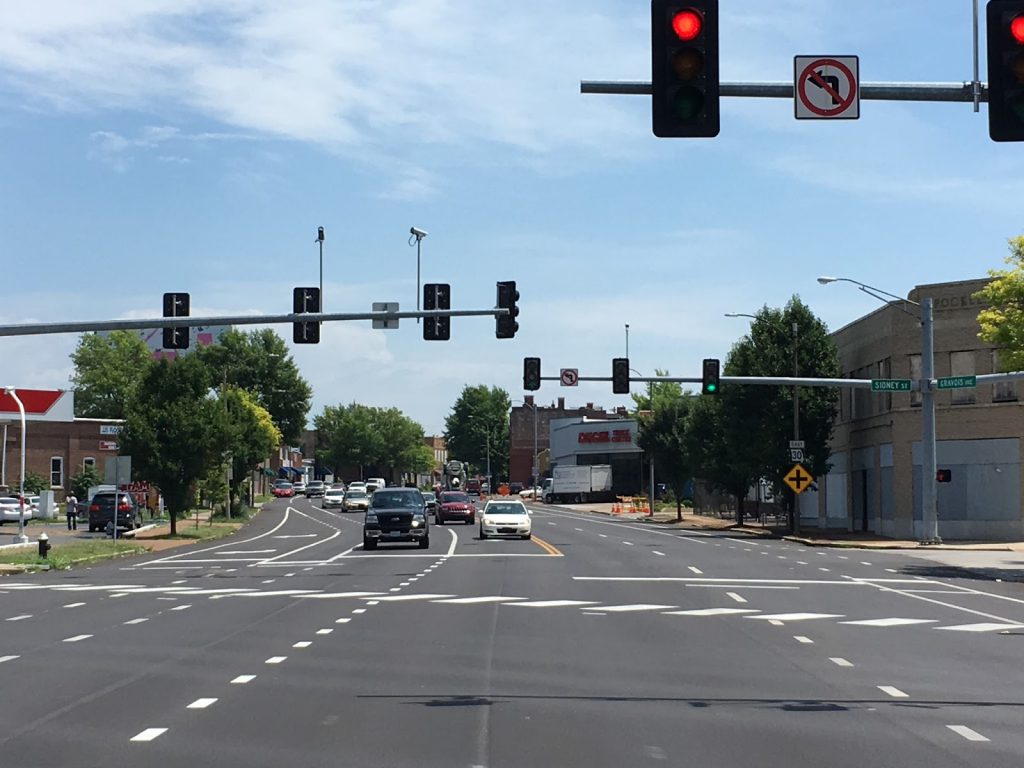 {Gravois at Jefferson, looking northeast, in its new configuration. A lane of traffic was removed in each direction, and replaced with bike lanes and a center turn lane. The road now also has several “zebra crosswalks” that increase pedestrian visibility.}
{Gravois at Jefferson, looking northeast, in its new configuration. A lane of traffic was removed in each direction, and replaced with bike lanes and a center turn lane. The road now also has several “zebra crosswalks” that increase pedestrian visibility.}
__________________________
Sometimes something other than a straightforward story is the best way to share a success story. Thanks to Joe for writing and allowing to re-post. This poem first appeared on Joe’s This damn city. blog.
